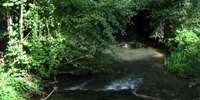Back to Don's Maps
 Back to Archaeological Sites
Back to Archaeological Sites
Hamburgian site in the Netherlands - The Perdeck Collection
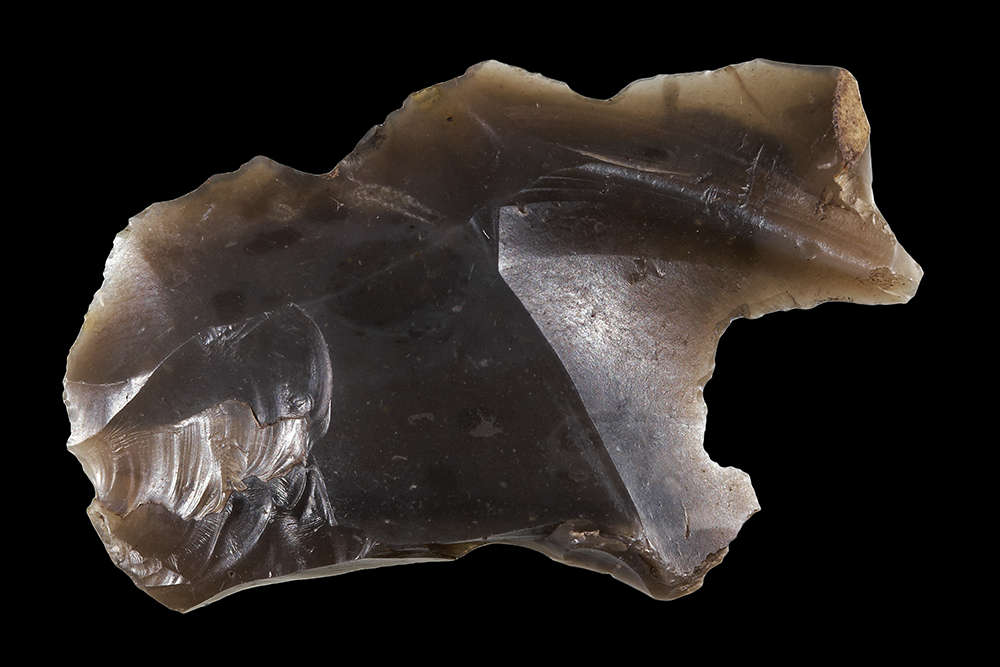
Beersculptuur op afslag - This flint has been retouched into a sculpture of a bear from a flake which suggested the form to the knapper. It is a superb piece of art.
Length 58 mm.
Collection: © Maarten Perdeck
Photo: © Christophe Brochard
Maarten Perdeck has collected more than 8 000 pieces of worked flint and 300 retouched tools on a Hamburgian site of just 200 m2 in the Netherlands, an upper palaeolithic reindeer hunter site from the end of the Weichselien. The tools reflect the type of the site, a camp for reindeer hunters, and consist mostly of scrapers, chisels, and drilling tools. The site is on top of a small hill, and would have provided good visibility of the surrounding countryside in the prevailing conditions at that time of almost treeless tundra.
Arrowheads of the Havelte and Gravette type are scarce since they were not needed for life in the tent, but basal fragments of the fragile shouldered Havelte points occur quite often since they came back from the hunt broken, but still attached to the shafts, and were discarded when a new point was attached to the shaft.
The artefacts have been superbly photographed by Christophe Brochard.
These superb specimens are mute testimony to the lives of the reindeer hunters who used the site many thousands of years ago, at a time when the ice caps were not far away from the Netherlands, where these pieces were found in a ploughed field over a period of twenty years.
The people who created these functional works of art were totally dependent on reindeer, and followed them from their summer grazing areas to their winter grazing areas, and back again. These tools were found in the summer grazing areas, at a time when the site was tundra, with few trees, and where the reindeer mostly subsisted on the lichens that grew in the brief four month period of summer, from June to September.
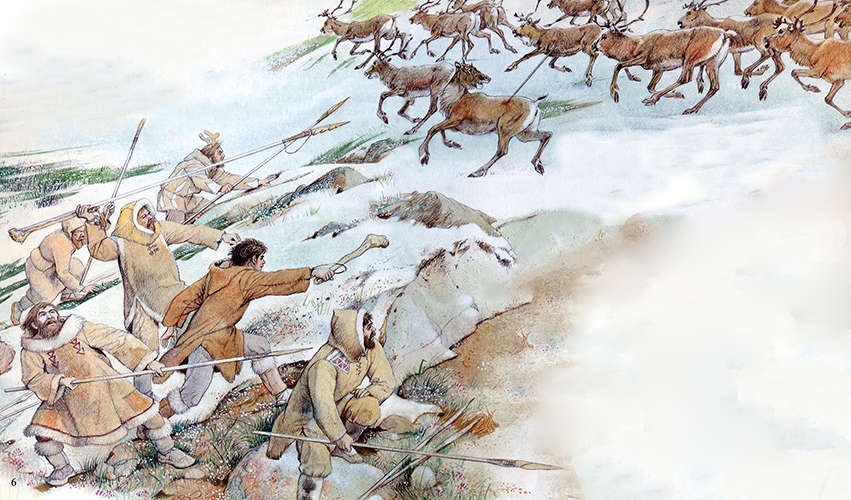
When hunting reindeer, the band cooperated closely. Their long, thin and flexible darts were launched from a spear thrower or atlatl, which was a lever which allowed the hunters to get a much greater range and force for their shafts. The darts were armed with both flint blades, especially the characteristic shouldered or tanged points of the Havelte type, and with barbed antler harpoons.
Reindeer antler is a strong, tough material, much stronger than, for example, red deer antler, and could be made into harpoon heads which were quite capable of bringing down an adult reindeer with one shot, a good cast blasting a hole through the shoulder blade of the reindeer, and immobilising the joint. This allowed the hunters to close with the animal, and finish it off.
The hunters aimed for the lifeline, a line connecting the heart and the mouth, and any spear which hit in that area would likely drop the reindeer in its tracks.
The animal would be dressed on the spot, with the abdominal cavity cleaned out and left for scavengers, and only the high value parts of the reindeer carried back to camp, with the load distributed amongst the hunting band.
We think of harpoons (that is, barbed bone or antler spear points) as being used for fish and large sea animals such as seals and whales, but they were first developed for reindeer hunting, and only later adapted for use with fish and marine mammals.
Photo and text: Adapted from Caselli (1985)
Additional text: Bibby (1956)
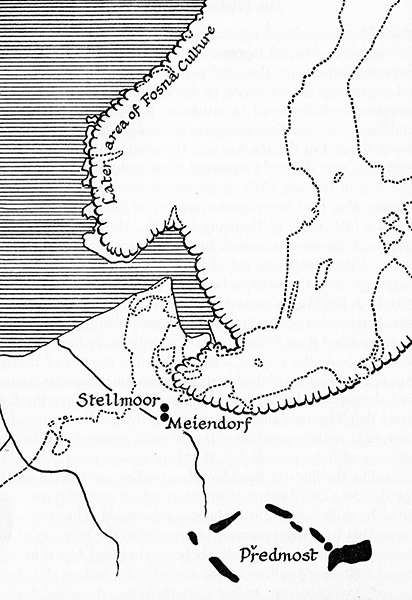
Northern Europe about 17 000 BP. The ice-cap has drawn back from all but the northern fringe of Germany, from the greater part of Denmark, and from the coasts of Norway. The sea, swollen by the melting ice, is creeping across the North Sea Plain to meet the Reindeer Hunters, whose summer camps at Meiendorf and Stellmoor may well have been less than 30 miles from the eternal ice.
Photo and text: Bibby (1956)
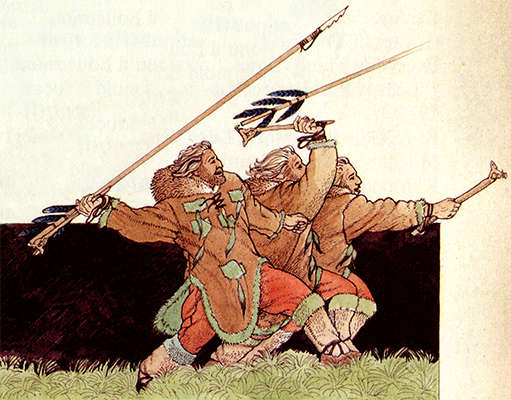
The darts and spear thrower were carefully made. The head of the spear often had a harpoon carved from reindeer antler instead of a flint point, with the harpoon mounted in such a way that it parted company with the shaft when the reindeer was struck, and there was less chance of either being broken.
The spear thrower gave much greater speed and distance to the spear because of the extra leverage gained.
A broken point or harpoon could be easily replaced in the field, but a dart was a big investment of time and effort, and was difficult to replace when there were few trees around, as was the case in the summer grazing grounds in the tundra.
One big advantage given by the development of the bow and arrow was that the shafts of the arrows were much shorter and thinner than darts, and very much easier to replace.
In addition, instead of just two or three unwieldy spears carried in the hand, dozens of arrows could be carried in a quiver on the back of the hunter, and the bow and arrow combination allowed the hunter to move into position quickly and easily, and to fire multiple shafts in a few seconds.
Photo: Caselli (1985)
Kerfspitsen van het type Havelte - Shouldered or Tanged points of the Havelte type.
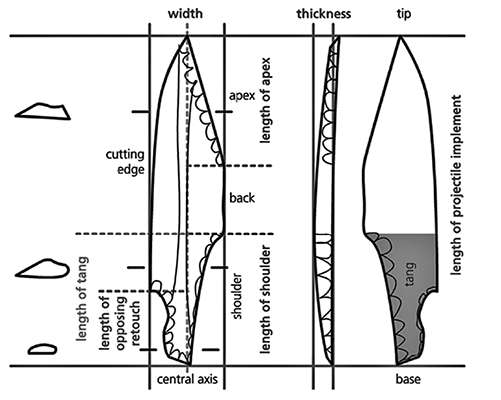
Idealised Havelte point with metric terms indicated.
The tang is here defined as the lower, articulated part of the
point and its length is consequently defined as the maximum length of the lower retouches.
Photo: Drawn by S.B. Grimm, in Grimm et al. (2012)
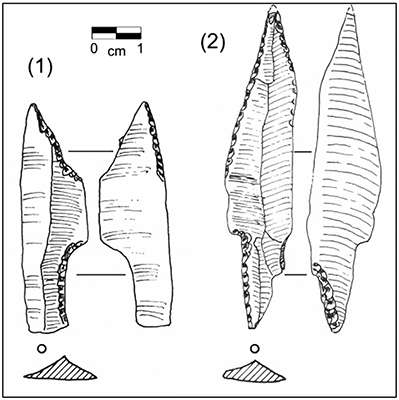
1. 'Classic' Hamburgian shouldered point.
2. Havelte shouldered point.
Photo and text: Riede (2010)
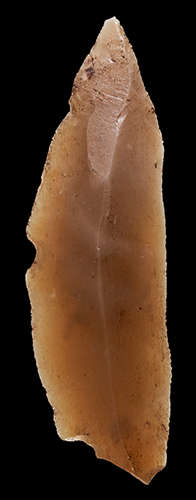
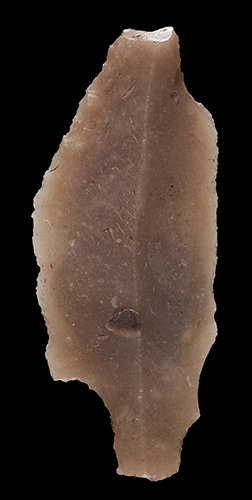
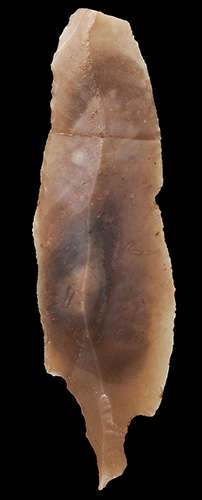
Kerfspitsen van het type Havelte - Shouldered or Tanged points of the Havelte type.
Lengths left to right: 48 mm, 27 mm, 48 mm.
Collection: © Maarten Perdeck
Photo: © Christophe Brochard

Havelte points have been dated to the late Hamburgian, and were most probably attached to arrows rather than darts ( Niekus et al., 2012 ).
Darts, arrows, spear throwers and bows would all have been most easily fabricated during winter in the margins of the forests at the far, southern end of the reindeer migration paths, where the forests began.
Wood suitable for arrow and spear or dart shafts would have been very difficult to obtain in the summer grazing areas in the tundra not very far from the ice sheets. Some small trees would have grown in sheltered positions, but the reindeer hunters would have brought most of their weapons with them, although flint for replacement points and other tools may have been available in the glacial till.
Photo: Instituut voor het Archeologisch Patrimonium (Zellik) (1994)
Artist: © Benoit Clarys
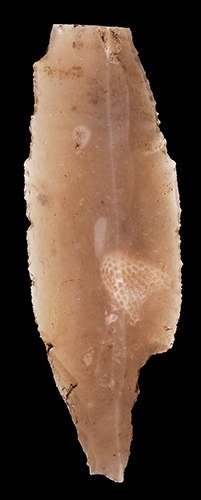
Kerfspits van het type Havelte - Shouldered or Tanged point of the Havelte type.
Length 35 mm.
This is a very special artefact - there is a fossil of a sponge embedded in it.
Collection: © Maarten Perdeck
Photo: © Christophe Brochard
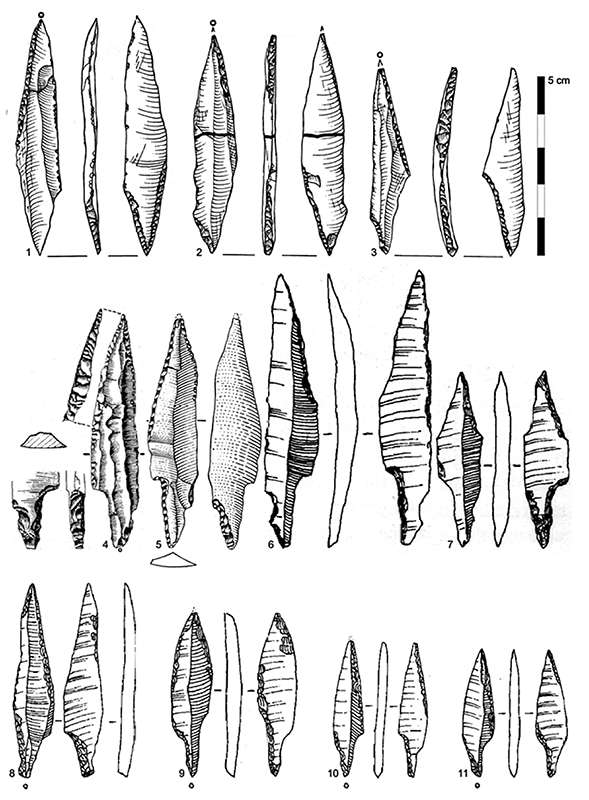
Examples of Havelte tanged points from Oldeholtwolde (nos. 1-3), Havelte-Holtingerzand (no. 4), Dörgener Moor (no. 5), Slotseng c
(nos. 6 & 7) and Jels 2 (nos. 8-11)
The actual use of Havelte tanged points as projectile implements was indicated by impact patterns and traces on certain specimens from different Havelte Group sites.
Whether Havelte tanged points armed spears or arrows remains a matter of debate. However, considering the weight of these examples, Havelte tanged points were more likely to be arrow points than spear points.
At the Danish Havelte Group site Slotseng a detailed botanical analysis was conducted on samples from the kettle hole where a horizon with humanly modified reindeer remains was found. This horizon was correlated with a maximum of pollen of buckthorn (Hippophaë rhamnoides), which is a typical pioneer plant. Comparable to the pollen, the macrofossils indicated a cold and open landscape with Dryas octopetala and first indicators of dwarf birch Betula nana as well as some remains of willow, Salix sp. However, the vegetation in this central part of Denmark must be described as sparse, reflecting an environment comparable to an arctic tundra at the time the reindeer were hunted there. The faunal remains from the kettle hole in Slotseng were comprised of bones and antlers of some 12 reindeer and some 14C dated samples attributed the assemblage to the Early Late Glacial Interstadial, with a weighted average date of ~14 000 BP.
According to the seasonal indications, the hunting occurred most likely around early November. Whether these remains originated from a single hunting event or recurrent episodes of seasonal hunts cannot be finally decided from the archaeological record. In the vicinity two concentrations of Havelte Group material (Slotseng a and c) as well as two further concentrations attributed to the Curve Backed Point (CBP) Groups were found. No other faunal assemblage is associated with a Havelte Group site and, consequently, little can be assumed about the Havelte Group subsistence strategies in general.
Photo and text: Grimm et al. (2012)
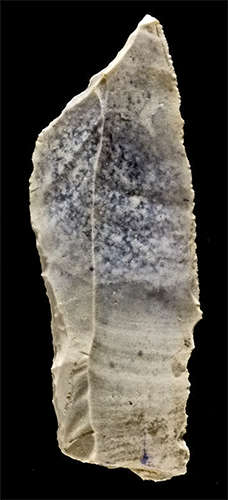
'Classic' Hamburgian shouldered point from Robin Hood Cave, Britain, Cat. +.7939
The point lacks a proximal end due to an ancient break. There is a tiny scalar retouch on the oblique left edge below the distal end which accentuates the point. There is an abrupt, scalar retouch extending from the distal end to above the midline which forms a shoulder on the left edge. The piece is fresh, with slight patination.
Findspot: Robin Hood Cave, Creswell Crags.
Length: 46.4 millimetres, Width: 16.4 millimetres, Thickness: 3.7 millimetres, Weight: 3 grams
Donated by: Sir Augustus Wollaston Franks
Excavated by: Rev John Magens Mello
Acquisition date: 1883
Photo and text: http://www.britishmuseum.org/
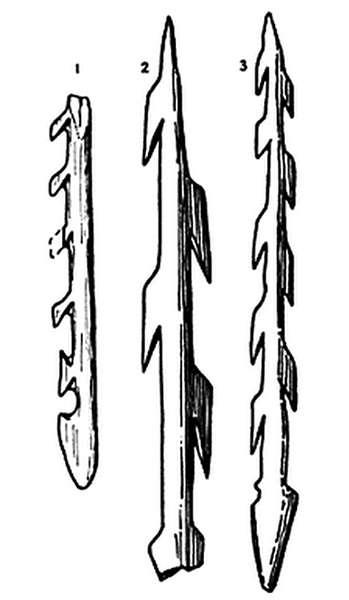
Harpoons of the Hamburgian and Ahrensburgian culture, made in reindeer antler.
1. Meiendorf
2. Stellmoor
3. Skaftelev
Photo and text: Clark (1966)

Harpoons in reindeer antler, barbed on both sides. Grotte de Lorthet (Hautes-Pyrénées).
Although these harpoons were found a long distance south from the Hamburgian culture sites, and are many thousands of years younger, they serve to show the effort that was put into making a simple weapon into a work of art.
Photo and text: Piette (1907)
Basale fragmenten kerfspitsen - Basal fragments of kerfspits, or shouldered points

Two views of a Pointe à cran, or shouldered point.
Date: between 22 000 and 17 000 BP, Upper Paleolithic (Solutrean)
Dimensions: 42 x 11 x 4 mm (1.7 × 0.4 × 0.2 in) - 1.3g
Current location: Museum of Toulouse
Accession number: MHNT.PRE.2009.0.226.2
Place of discovery: Grotte de L’église, Saint-Martin near Excideuil, Dordogne, France – Former collection of J. & P. Parrot.
Photo: Didier Descouens, 31 December 2010
Permission: Creative Commons Attribution-Share Alike 3.0 Unported license
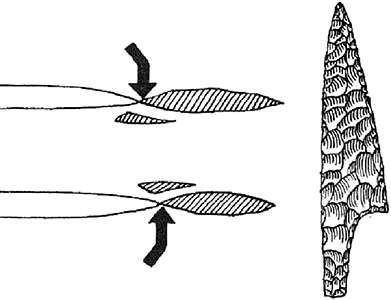
End-on views of pressure-flaking show how force is applied to the tool edge itself to make the shoulder of a shouldered point. Controlled fracturing with this method results in finer flakes and finer tools, like the leaf point at right.
Photo and text: Howell (1965), drawings by Lowell Hess.
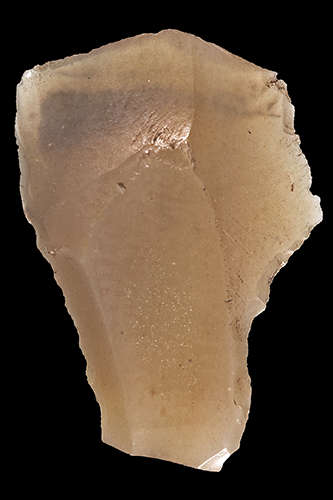
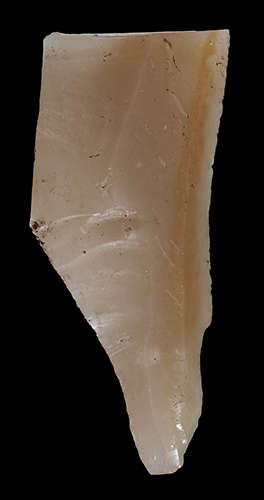
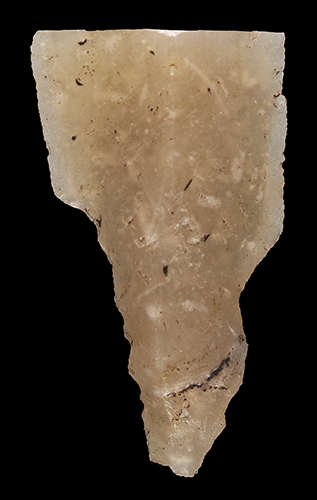
Basale fragmenten kerfspitsen - Basal fragments of shouldered points, or Pointes à cran.
Lengths left to right: 20 mm, 28 mm, 21 mm.
Collection: © Maarten Perdeck
Photo: © Christophe Brochard
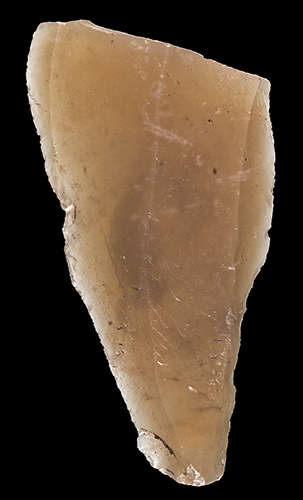
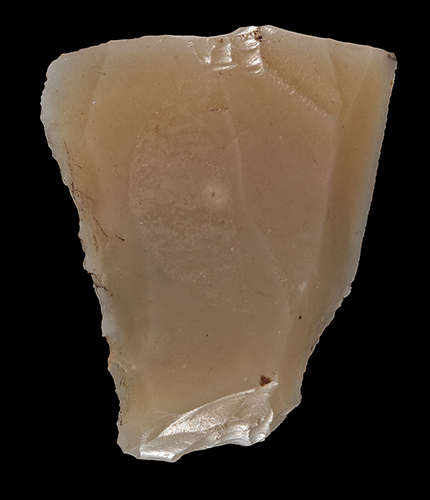
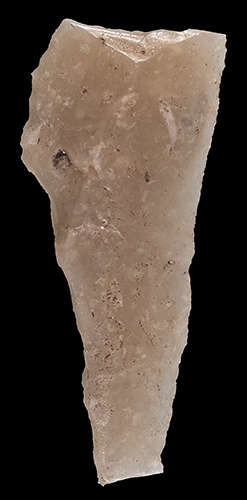
Basale fragmenten kerfspitsen - Basal fragments of shouldered points, or Pointes à cran.
Lengths left to right: 21 mm, 14 mm, 21 mm.
Collection: © Maarten Perdeck
Photo: © Christophe Brochard
Distale fragmenten spitsen - Distal fragments of points
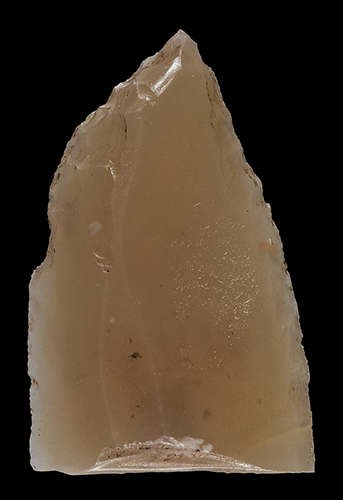
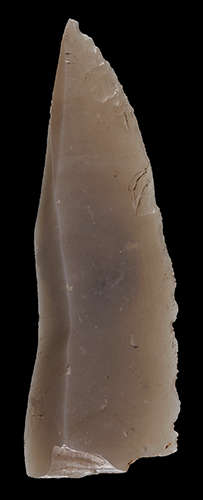
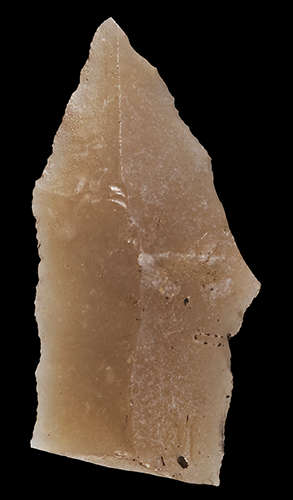
Distale fragmenten spitsen - Distal fragments of points.
Lengths left to right: 14 mm, 33 mm, 21 mm.
Collection: © Maarten Perdeck
Photo: © Christophe Brochard
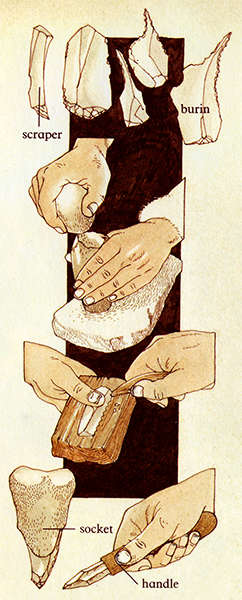
Burins and scrapers and knives were essential tools in the life of the reindeer hunters.
Southern Europe below the Scandinavian Peninsula is fortunate in having vast deposits of limestone and the flint nodules that are often found in them.
Photo: Caselli (1985)
Krombekstekers - Curved tip beaked burins - Parrot Beak Burins

Alfred Rust, a pioneer in the study of the Reindeer Hunters was the first to identify this type of burin in the tool set of what became known as the Hamburg Culture, and lightheartedly wanted to call it the 'Papageienschnabelklingenendhohlkratzerbohrerschraber ' or Parrot-beak-blade-end-groove-scratcher-bore-scraper. He had found it first in the Ahrensburg valley in a meadow called Meiendorf, and recognised it in the collections of Dr Albrecht of Kiel University, who had collected it in a field a little north of Hamburg.
Rust found close by his original ploughed field of Meindorf a site which had been a lake, and into which all manner of detritus had been thrown by the Reindeer Hunters who had camped by its shores. It was what he had been searching for, a stratified site, not a ploughed field which was where all the previous discoveries had been made. When he excavated to the original lake bed, he found what he was looking for - a four foot (120 cm) long reindeer antler, from which a sliver eighteen inches (50 cm) in length had been cut out.
It was at once clear that the purpose of the parrot-beak-groove-scratcher was as a tool to be used to cut out slivers of reindeer antler for fashioning into pins and arrowheads and flint-flakers.
With hard work and the spirit of innovation, Rust used new methods (soil coring, excavation in floodplains with drainage by pumps) to examine the layers of peat around the areas left by the melting of the ice sheet which currently form the Meiendorfer Ahrensburg valley, near Hamburg.
Rust showed (which was denied at the time) that groups of hunter-gatherers frequented the tundra stretching to the foot of the huge glaciers that covered northern Europe during the Ice Age. He found numerous flint tools (awls, scrapers, chisels for working bone and antler, pairs of blades for mounting on a pair of scissors) and carved stone, wood or bone weapons (spears). He also discovered the bones of sacrificed animals, especially deer, found intact except for a large stone which was placed intentionally in the thorax of each animal.
Among his other notable discoveries were an amber plate with a hole and engraved figures (horse, bird, fish), a finely carved and incised stick, and a baton decorated with a large pair of reindeer antlers.
Rust, through his discoveries in the field excavations at Meiendorf, showed that reindeer hunters belonging to the Hamburg culture in the late Palaeolithic were hunting in this region about 15 000 years ago. During a period of warmer climate, about 13 400 years ago, hunters belonging to the Magdalenian culture also lived at the foot of glaciers until a new cold period, 12 700 years ago, after which appeared the reindeer hunting Ahrensburg culture.
Photo: http://www.pkaj.dk/stellmoor_lokaliteten.asp
Text above adapted from Bibby (1956) and Wikipedia

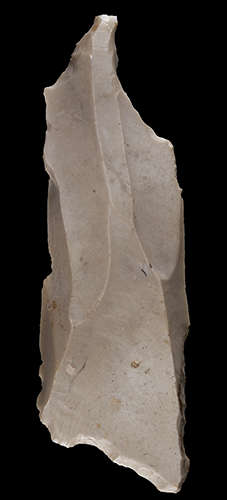
On the left is the 'Parrot-beak-groove-scratcher', the artefact type which set Rust upon the trail of the Hamburg Reindeer Hunters.
The specimen on the right, from the Perdeck collection in the Netherlands, with a length of 64 mm, is virtually identical to the ones that Rust found in Meiendorf, shown in the diagram.
(left) Photo and text: Bibby (1956)
(right) Collection: © Maarten Perdeck
(right) Photo: © Christophe Brochard
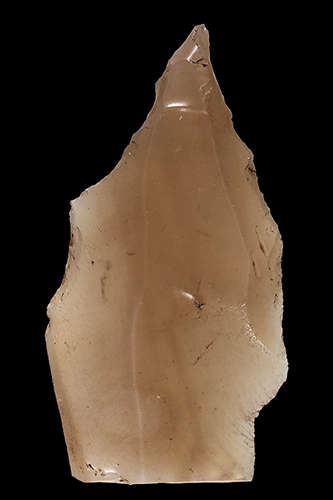
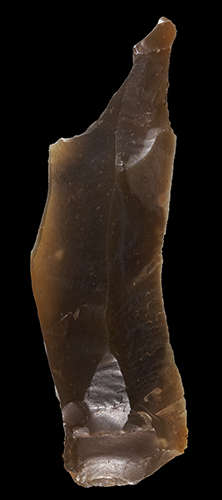
Krombekstekers - Curved tip beaked burins.
Lengths left to right: 26 mm, 54 mm.
Collection: © Maarten Perdeck
Photo: © Christophe Brochard
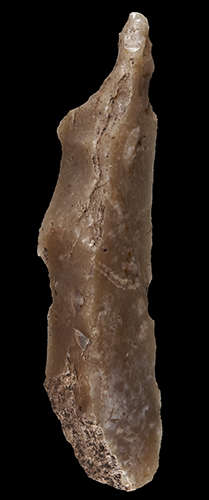
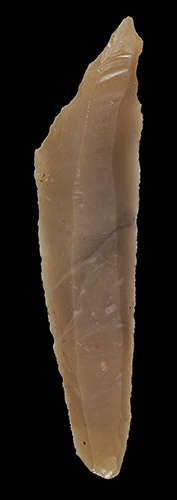
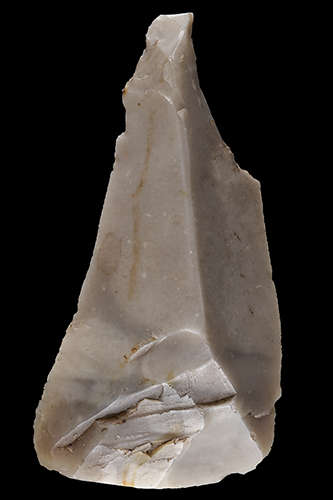
Krombekstekers - Curved tip beaked burins.
Lengths left to right: 56 mm, 53 mm, 58 mm.
Identifications left to right: Z.10, Z.11, Z.12
Collection: © Maarten Perdeck
Photo: © Christophe Brochard

Krombekstekers - Curved tip beaked burins, drawings of the same artefacts as in the images immediately above.
Identifications left to right: Z.10, Z.11, Z.12
These are from the journal in which the flint tools were first described.
Photo: Perdeck (1993)
Drawings: Tekeningen: Hans Peeters
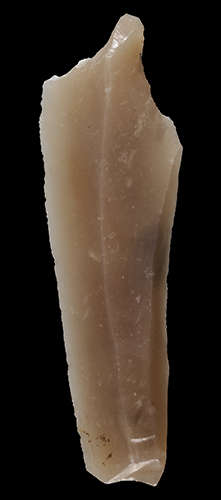
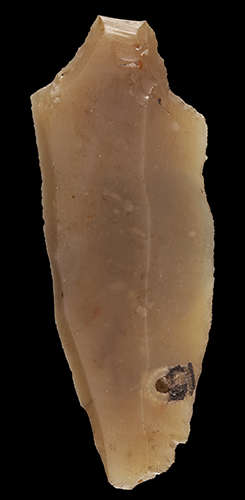
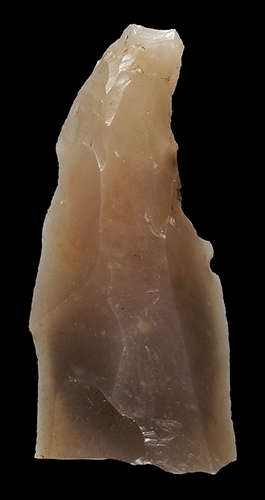
Krombekstekers - Curved tip beaked burins.
Lengths left to right: 46 mm, 53 mm, 26 mm.
Identifications left to right: Z.13, Z.14, Z.18
Collection: © Maarten Perdeck
Photo: © Christophe Brochard

Krombekstekers - Curved tip beaked burins, drawings of the same artefacts as in the images immediately above.
Identifications left to right: Z.13, Z.14, Z.18
Photo: Perdeck (1993)
Drawings: Tekeningen: Hans Peeters
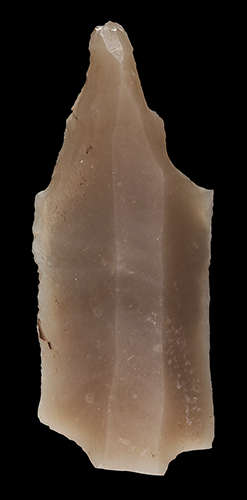
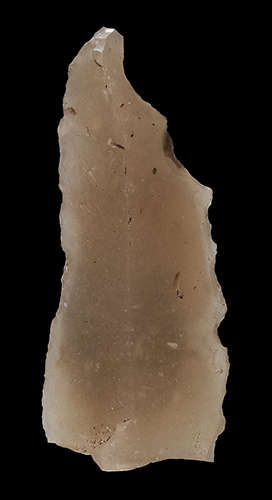

Krombekstekers - Curved tip beaked burins.
Lengths left to right: 24 mm, 23 mm, 22 mm.
Identifications left to right: Z.19, Z.20, Z.21
Collection: © Maarten Perdeck
Photo: © Christophe Brochard
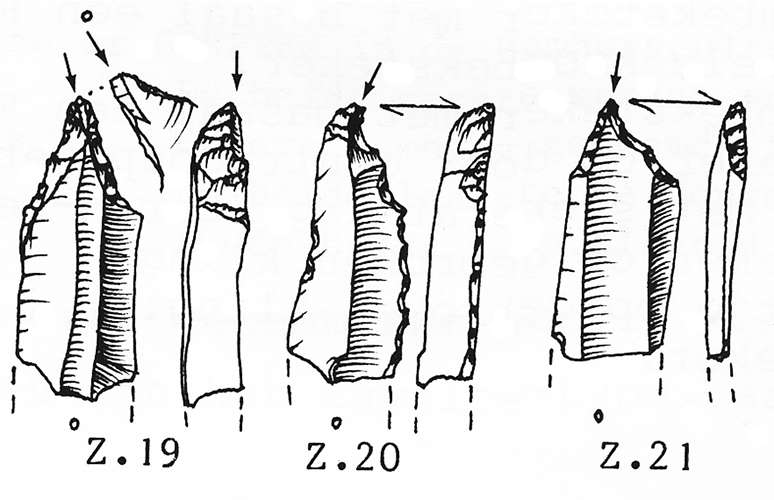
Krombekstekers - Curved tip beaked burins, drawings of the same artefacts as in the images immediately above.
Identifications left to right: Z.19, Z.20, Z.21
Photo: Perdeck (1993)
Drawings: Tekeningen: Hans Peeters
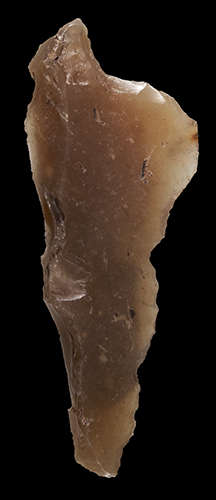
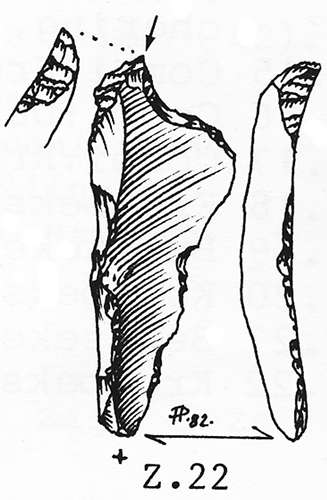
Krombeksteker - Curved tip beaked burin.
Length: 36 mm.
Identification: Z.22
Collection: © Maarten Perdeck
Photo (left): © Christophe Brochard
Photo (right): Perdeck (1993)
Drawing: Tekening: Hans Peeters
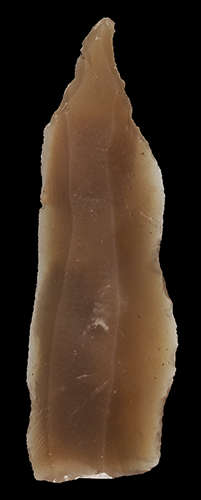
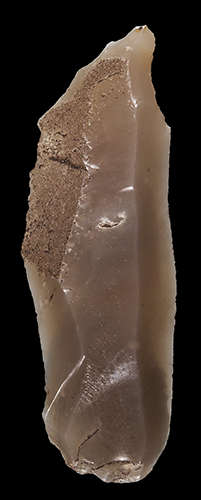
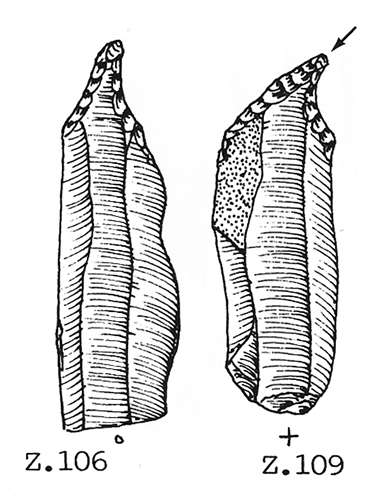
Krombekstekers - Curved tip beaked burins.
Lengths left to right: 38 mm, 35 mm.
Identifications left to right: Z.106, Z.109
Collection: © Maarten Perdeck
Photo (left and centre): © Christophe Brochard
Photo (right): Perdeck (1993)
Drawings: Tekeningen: Ad Wouters
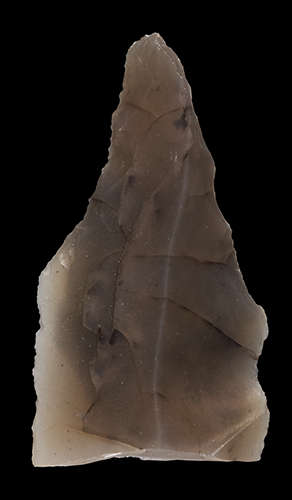
Krombeksteker verbrand - Curved tip beaked burin, burnt in a fire.
Length: 15 mm.
Collection: © Maarten Perdeck
Photo: © Christophe Brochard
Definitions and knapping techniques for Burins
Readers should note that some Dutch language terms for stone tools have entered the literature as abbreviations, and are used widely in English language journals and books.
One of these is the 'A burin', which comes from the Dutch, Afslag (blade or flake, mostly on transversal break). In fact most burins are made by a transversal break on small blades.
Another is the RA burin, which comes from the Dutch, Retouche - Afslag (Retouch - blade / flake on truncation).
RA burins are made by breaking the end off a blade, blunting it, then using the coup de burin, the burin blow, to detach the burin spall by striking the blunted platform.
The AA burin is also Dutch, Afslag - Afslag (blade / blade or flake / flake, dihedral).
AA burins are thus dihedral burins, or in French, Becs de flûte.

One method of making either:
Blunted Burin - an RA Steker
or
Dihedral Burin - AA Steker - Bec-de-Flûte
Starting with a blade, the toolmaker first snaps the pointed end at an oblique angle (left).
Next, using a wood or antler hammer, they chip the broken end to make a striking platform, then dull one edge (two views, second drawing).
The toolmaker may now make either a single blunted burin, i.e. an RA Steker, or a Dihedral Burin, i.e. an AA Steker, as in the third and fourth drawings.
Photo: Howell (1965), drawings by Lowell Hess.
Text: adapted from Howell (1965)

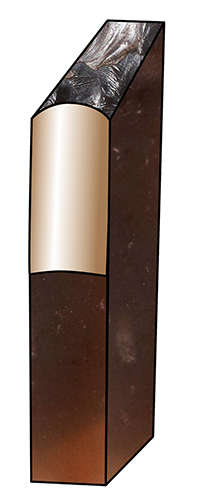
The classic 'Burin Blow' or 'Coup de Burin' is made by first blunting the end of the flake or blade. The blunted edge is then struck with a wooden or antler implement, and a burin spall is detached from the tool. This leaves a cutting edge that shaves razor-like at the bottom and edges of a groove when the burin is drawn edgewise toward the user.
This tool is the blunted burin, or RA Steker. The diagram on the right shows how the burin blow creates the razor sharp edges on each side of a trough or groove, which are so effective in carving materials such as wood, antler and bone.
Photo (left): José-Manuel Benito Álvarez
Permission: Creative Commons Attribution-Share Alike 2.5 Generic license.
Photo (right): Don Hitchcock 2014
Text: Adapted from J.L. Giddings, http://pubs.aina.ucalgary.ca/arctic/Arctic9-4-229.pdf
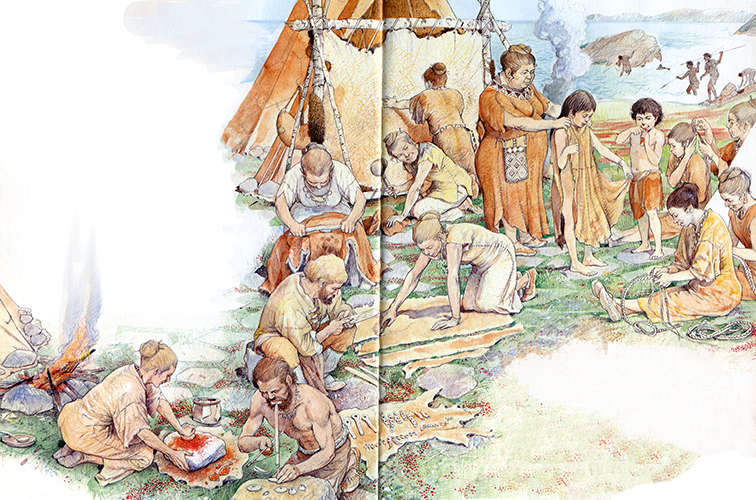
Once hunting commenced, a constant supply of hides provided the raw materials for repair of tents, new clothes, plaited ropes, and carrying bags of all kinds. The hides had to be scraped clean of all the membranes and fats and flesh, and then worked to ensure that they stayed pliable and useful.
Huge amounts of time and tools were expended on this task, for it was essential to the continued existence of the reindeer hunters.
The most important flint tools for the reindeer hunters apart from spear points were burins, for carving bone and antler into harpoons and many other useful tools, and scrapers, for working hides.
The average band of perhaps twenty people hunted and butchered a reindeer on average every second day over the four months of summer, from June to September, so that the demands of food and clothing and replacement of tools could be met.
One large reindeer could provide up to 100 lbs, or 45 kg of meat. The reindeer hunters lived well in good times, with plenty to eat and no lack of resources for their lives.
Photo and text: Adapted from Caselli (1985)
Additional text: Bibby (1956) and http://www.adfg.alaska.gov/index.cfm?adfg=caribouhunting.main
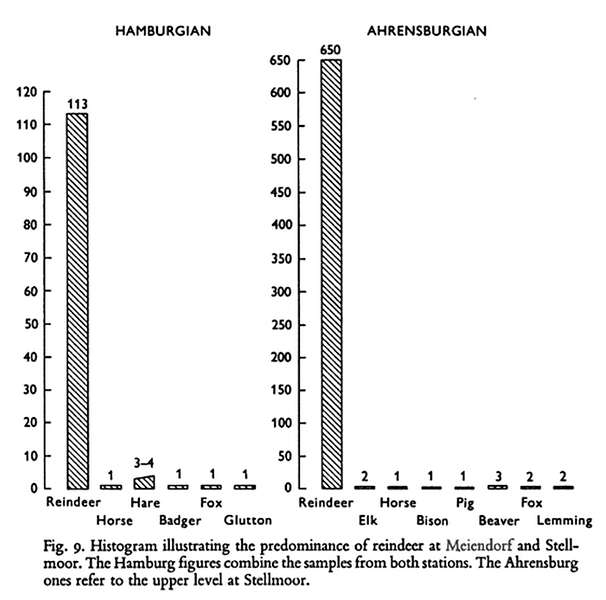
These graphs demonstrate the near total reliance on reindeer for sustenance and materials by both the Hamburgian and the Ahrensburg cultures.
Photo: Clark (1966)
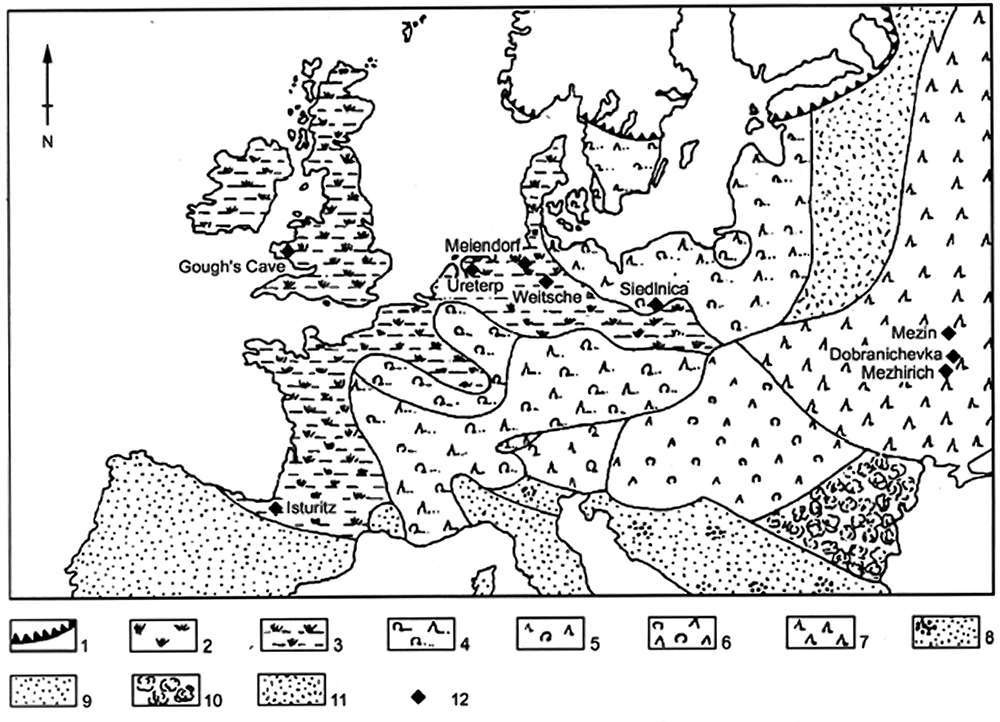
Map of the vegetation in Europe between 13 000 BP and 12 000 BP.
1 - Ice sheet
2 - Tundra
3 - Tundra 'xeric' variant (i.e. dry tundra)
4 - Birch-Pine forest
5 - Mixed forest
6 - Northern mixed conifer-deciduous forest
7 - Spruce dominated forest
8 - Steppe with Gramineae (now called Poaceae)
9 - Steppe (i.e. vast semi-arid grass-covered plain, as found in southeast Europe, Siberia, and central North America)
10 - Mixed-deciduous forest
11 - Mixed forest
12 - Sites with amber artefacts
Photo: Burdukeiwicz (1999)
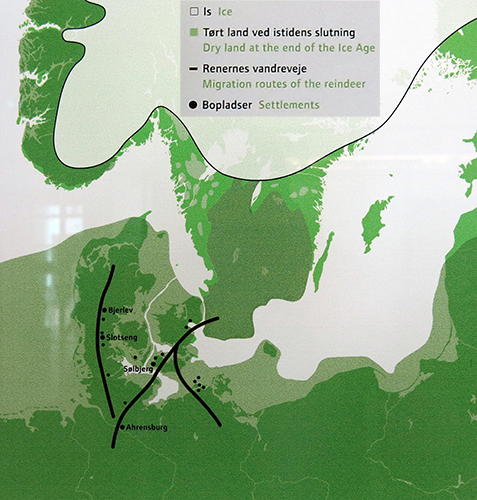
Hunting on the tundra
The Cro-Magnons came to Europe in a mild climatic period. Their settlements were scattered all over central Europe. Slowly the climate got colder. When Ice Age glaciers covered northern Europe around 20 000 BP, man had moved further south. In southern Europe the hunting culture survived the coldest period of the Ice Age. When the climate improved people quickly moved north. Wild horses and mammoths lived on the tundra, but it was mainly reindeer hunting that brought humans to Denmark 14 000 years ago. Here the hunters pitched their tents on windswept hills with a view of the migration routes of the reindeer.
Sea level was still low at the end of the Ice Age, ca 9 000 BP. The Baltic Sea was full of meltwater that ran into the sea via a river in the Øresund. The reindeer had fixed migration routes on the tundra, and the hunters' settlements lay along these routes.
Photo: Don Hitchcock 2014
Source and text: Københavns (Copenhagen) Museum, National Museum of Denmark
Stekers - Burins
A burin is a special type of lithic flake with a chisel-like edge which prehistoric humans used for engraving or for carving wood or bone. Burins exhibit a feature called a 'burin spall', in which toolmakers strike a small flake obliquely from the edge of the burin flake in order to form the graving edge. Burin usage is diagnostic of Upper Palaeolithic cultures in Europe.Text above: Wikipedia
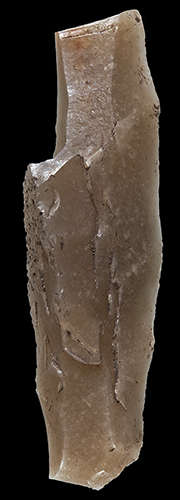


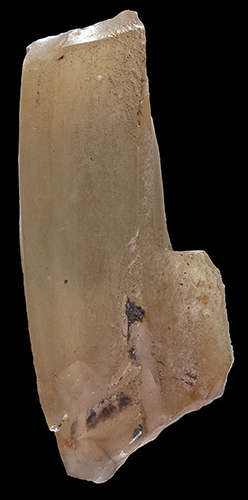
A Stekers - Burins of the A type, formed on the end of a blade by a coup de burin, the burin blow, without blunting first.
Readers should note that some Dutch language terms for stone tools have entered the literature as abbreviations, and are used widely in English language journals and books.
One of these is the 'A burin', which comes from the Dutch, Afslag (blade or flake, mostly on transversal break). In fact most burins are made by a transversal break on small blades.
Lengths left to right: 40 mm, 50 mm, 55 mm, and 26 mm.
Collection: © Maarten Perdeck
Photo: © Christophe Brochard

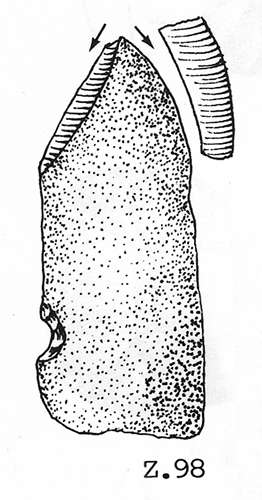
AA Steker - Burin bec-de-flûte.
Length: 45 mm.
The burin bec-de-flûte or dihedral burin is the simplest of all conventional burins. The bevel, placed at the end of the blade, is formed from two sides which meet at an acute dihedral angle whose edge is perpendicular to the plane of the blade.
Identification: Z.98
Collection: © Maarten Perdeck
Photo (left): © Christophe Brochard
Photo (right): Perdeck (1993)
Drawing: Tekening: Ad Wouters
Text: Cheynier (1963)
Dubbele Stekers - Double Burins
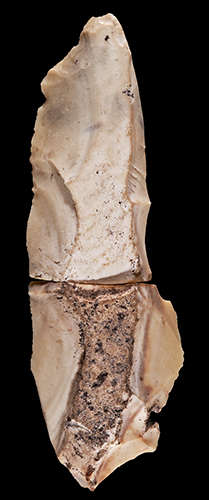
Dubbele RA steker - this is a blunted double burin, with a burin on each end of the tool. First the craftsman blunted the end of (usually) a blade and then added one or more graver or burin blows on the blunted 'platform'.
Length: 56 mm.
Collection: © Maarten Perdeck
Photo: © Christophe Brochard
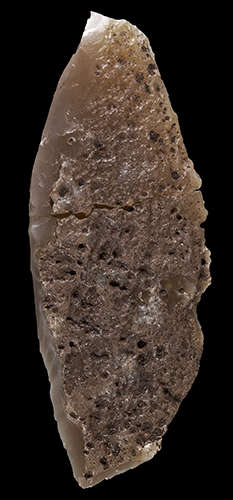
RA en AA steker op splijtstuk - RA and AA type burins, one on each end of a z28sm tool.
Readers should note that some Dutch language terms for stone tools have entered the literature as abbreviations, and are used widely in English language journals and books.
One of these is RA burin, which comes from the Dutch, Retouche - Afslag (Retouch - blade/flake on truncation).
RA burins are made by breaking the end off a blade, blunting it, then using the coup de burin, the burin blow, to detach the burin spall by striking the blunted platform.
AA burin is also Dutch, Afslag - Afslag. (blade / blade or flake / flake, dihedral).
AA burins are thus dihedral burins, or in French, Becs de flûte.
Collection: © Maarten Perdeck
Photo: © Christophe Brochard
Text: Cheynier (1963)

RA en AA steker - RA and AA type burin on the same blade.
Length: 41 mm.
Collection: © Maarten Perdeck
Photo: © Christophe Brochard
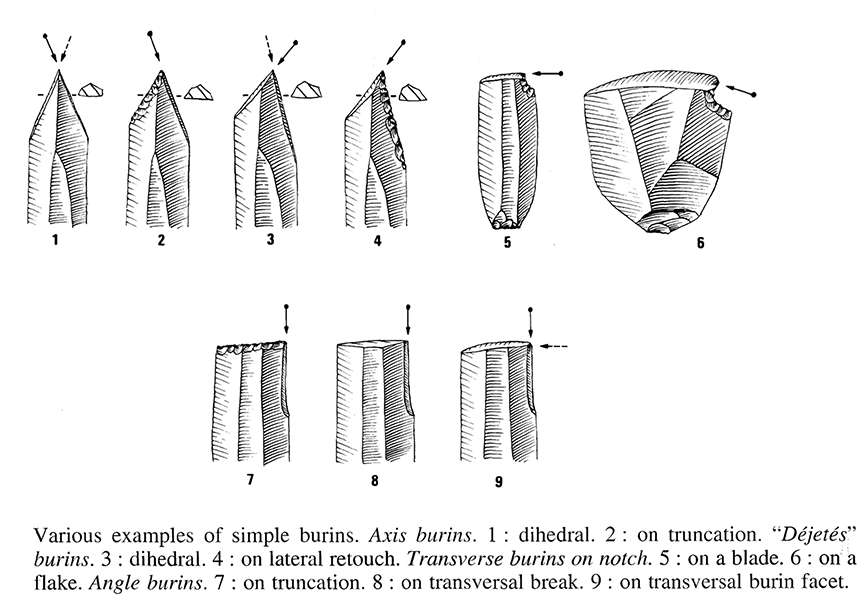
Simple types of burins.
Photo: Inizan et al. (1999)
RA Stekers - RA type Burins - Blunted Burins
RA burins are made by breaking the end off a blade, blunting it, then using the coup de burin, the burin blow, to detach the burin spall by striking the blunted platform.
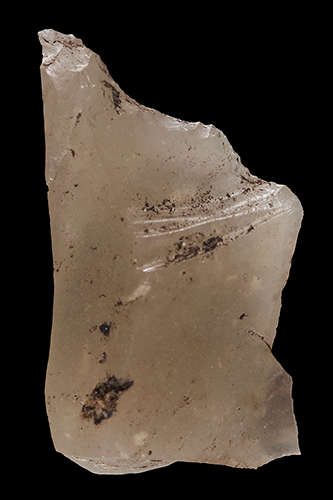
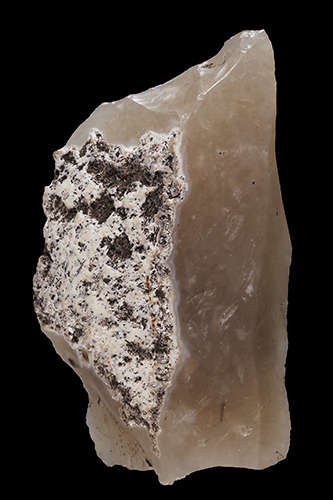
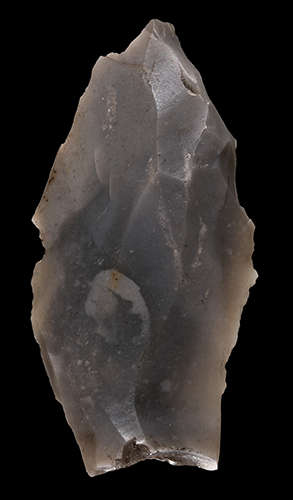
RA stekers - RA type burins.
Lengths, left to right: 16 mm, 29 mm, 33 mm.
Collection: © Maarten Perdeck
Photo: © Christophe Brochard
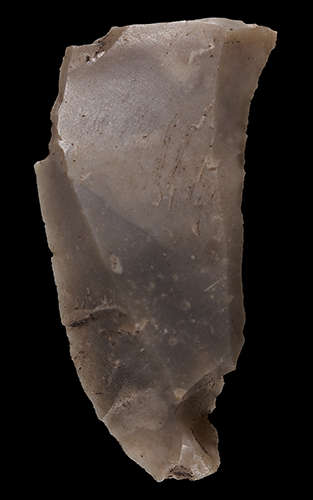
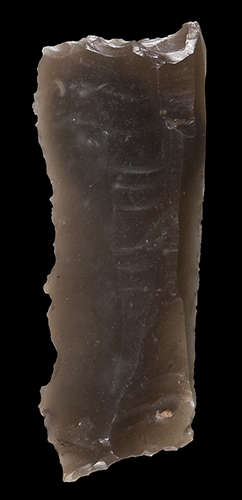
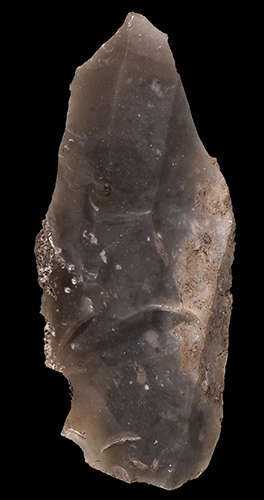
RA stekers - RA type burins.
Lengths, left to right: 16 mm, 36 mm, 40 mm.
Collection: © Maarten Perdeck
Photo: © Christophe Brochard



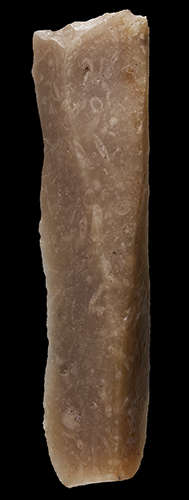
RA stekers - RA type burins.
Lengths, left to right: 47 mm, 51 mm, 43 mm, 45 mm.
Collection: © Maarten Perdeck
Photo: © Christophe Brochard
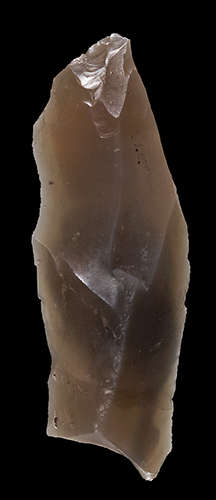
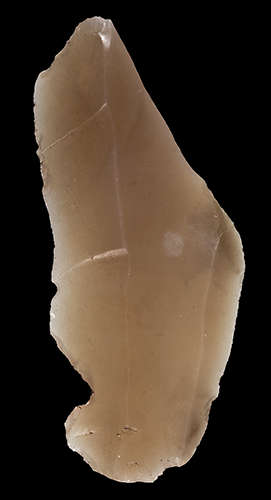
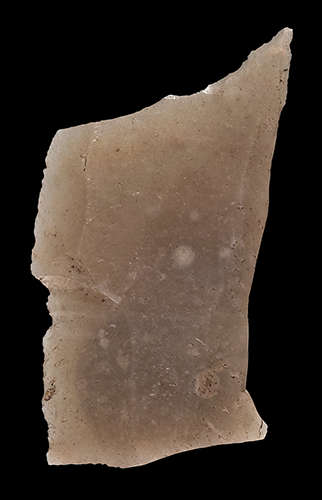
RA stekers - RA type burins.
Lengths, left to right: 39 mm, 38 mm, 25 mm.
Collection: © Maarten Perdeck
Photo: © Christophe Brochard
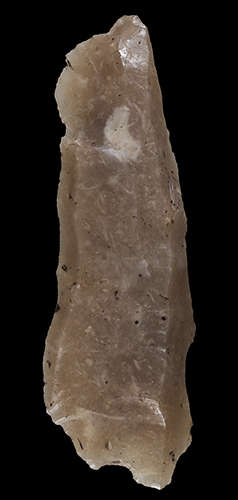
RA steker met holschaaf - RA type burin with a concave blade for creating a curved, convex, moulded edge.
Length: 82 mm.
Collection: © Maarten Perdeck
Photo: © Christophe Brochard
Hamburgian Culture
The Hamburg culture or Hamburgian (15 500 - 13 100 BP) was a Late Upper Paleolithic culture of reindeer hunters in northwestern Europe during the last part of the Weichsel Glaciation beginning during the Bölling Interstatial. Sites are found close to the ice caps of the time.The Hamburg Culture has been identified at many places, for example, the settlement at Meiendorf and Ahrensburg north of Hamburg, Germany. It is characterised by shouldered points and zinken tools, which were used as burins when working with horns. In later periods tanged Havelte-type points appear, sometimes described as most of all a northwestern phenomenon. Notwithstanding the spread over a large geographical area in which a homogeneous development is not to be expected, the definition of the Hamburgian as a technological complex of its own has not recently been questioned.
The culture spread from northern France to southern Scandinavia in the north and to Poland in the east. In the early 1980s, the first find from the culture in Scandinavia was excavated at Jels in Sønderjylland. Recently, new finds have been discovered at, for example, Finja in northern Skåne. The latest findings (2005) have shown that these people traveled far north along the Norwegian coast dryshod during the summer, since the sea level was 50m lower than today.
In northern Germany, camps with layers of detritus have been found. In the layers, there is a great deal of horn and bone, and it appears that the reindeer was an important prey. The distribution of the finds in the settlements show that the settlements were small and only inhabited by a small group of people. At a few settlements, archaeologists have discovered circles of stones, interpreted as weights for a tent covering.
Text above: Wikipedia

Numerous reindeer standing on patches of snow during summer to avoid blood-sucking mosquitoes and gadflies. Reindeer migrate to summer pastures not just for the grazing, but to avoid the worst of the insects.
Photo: Bjørn Christian Tørrissen
Permission: Creative Commons Attribution-Share Alike 3.0 Unported license
Text: adapted from Wikipedia
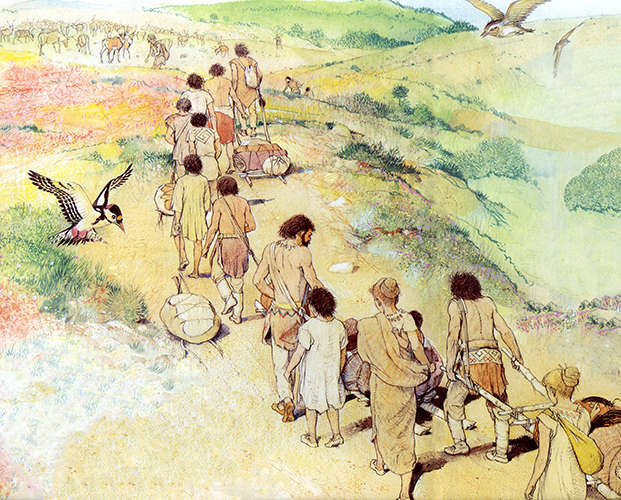
For weeks in the spring, the youngsters in the hunting band had been watching the reindeer in their winter, southern feeding grounds, and now the reindeer became restless, and began to move north to summer pastures. Their excited reports transformed the camp, which had been ready for this for a long time, and within a few hours everything was packed and in readiness for the long trek to the north, following the reindeer.
The reindeer mostly followed much the same path, but that was not always the case, and the life of the hunters was based around reindeer. Their main food was reindeer meat, though they varied it where possible, and their clothing, tools, weapons and tents were totally dependent on the harvest of reindeer.
The route taken by the huge herd of reindeer was easy to follow, but they never let the reindeer get too far ahead. The journey took a long time, but eventually they arrived in the north where the reindeer spread out on the tundra to graze, and the hunters set up camp near a good supply of water such as one of the glacial lakes that dotted the confused drainage of the tundra, and settled in for summer.
Photo and text: Adapted from Caselli (1985)
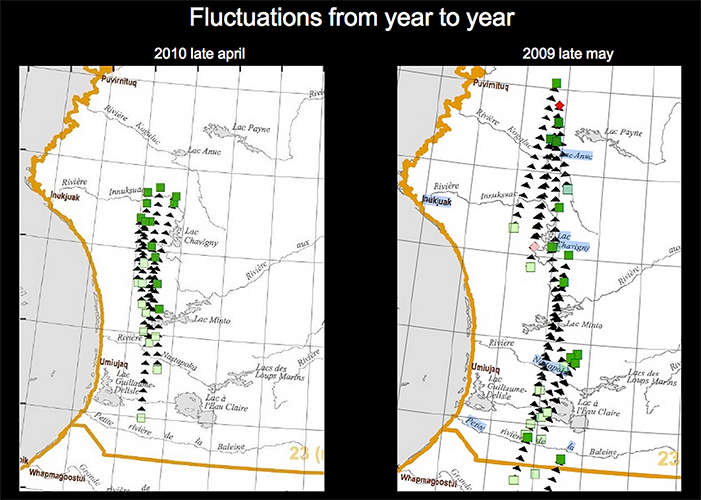
The reindeer hunters may have had to be flexible so far as meeting up with the migrations of the reindeer was concerned, depending on local conditions.
Migration paths were not necessarily fixed in stone, as these maps of the variation in caribou (reindeer) migrations on the shores of Hudson Bay, Canada, demonstrate.
Photo: Pedersen (2013)
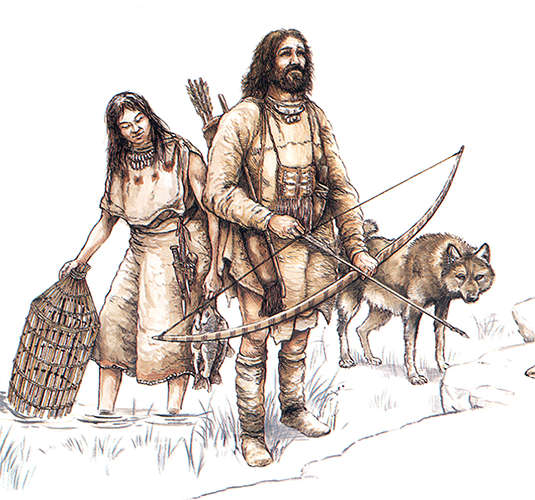
The people of the Hamburgian and Ahrensburg culture moved with the herds. Reindeer were their prime sustenance, for food, clothing, hides and weapons. This painting is more slanted to the Ahrensburg culture of Stellmoor, since the Hamburgian culture of Meiendorf mostly used spears thrown by spear throwers, and apparently did not have dogs, and the Ahrensburg mostly used bows and arrows, and had at least partly domesticated the dog. Both were summer camps to hunt reindeer, both were located by small lakes, and the two sites were only separated by 1300 metres.
Both had similar toolkit and cultural practices, including sacrificing the first prime reindeer of the season by sewing rocks in its abdominal cavity, and casting it into the lake. There was one such reindeer at the Hamburgian culture type site at Meiendorf, a site which was probably only used for one season, and more than thirty at the Ahrensburg culture at Stellmoor, a site which was used for a generation.
A reasonable hypothesis is that the Hamburgian culture typified by Meiendorf lasted from about 15 500 to 13 000 BP, and the Ahrensburg typified by Stellmoor existed from about 12 500 to 11 000 BP.
Photo: http://www.pkaj.dk/stellmoor_lokaliteten.asp
Bekstekers - Beaked Burins - Zinken
The beaked burin is especially common in the Middle Aurignacian. In appearance it rather resembles the prow of a ship turned upside down; the working edge is convex, being formed by a flat graver facet on one side, and a series of convex graver facets up the prow; this produces a keeled scraper made on the breadth of a blade. There are two sub-varieties, one with a notch to prevent the little convex graver facets from going too far down the blade, and the other without. Burkitt (1925)
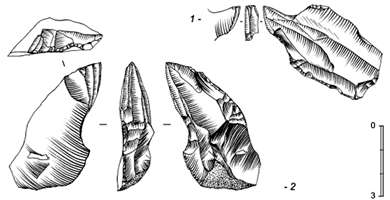
Burin busqué - the Beaked Burin
Burin busqué, n°1 : shelter 2, layer 2 and burin busqué of the Vachons type, n°2 : shelter 1, layer 2 (drawings D. Pesesse).
Photo and text: Pesesse et Michel (2008)

Burin busqué - the Beaked Burin
Three or more fairly regular spalls, often removed from a Spall Removal Surface (SRS) of dihedral type, approximate a semicircle. An edge of this shape is sometimes described as the gouge or busqué or hooked type.
(This is an excellent diagram of what I think of as a "classic" beaked burin, as described by Burkitt (1925). Note the front vertical spall, and the notch taken out of the rear of the burin to make sharpening easier, so that a spall comes off easily when retouching - Don )
Photo and text: Movius et al (1968)
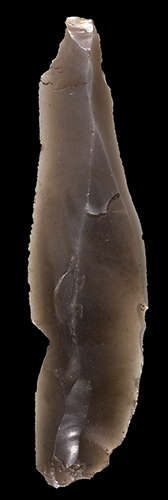
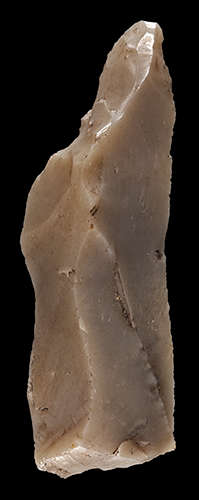

Bekstekers - Beaked Burins - Zinken
Lengths left to right: 42 mm, 38 mm, 95mm.
Collection: © Maarten Perdeck
Photo: © Christophe Brochard
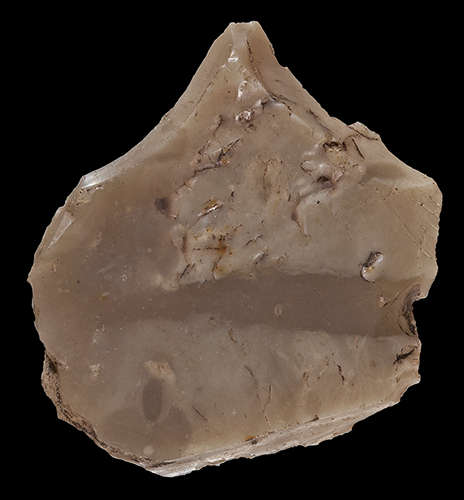
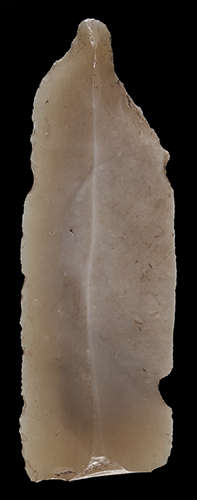
Bekstekers - Beaked Burins - Zinken
Lengths left to right: 30 mm, 46 mm.
Collection: © Maarten Perdeck
Photo: © Christophe Brochard
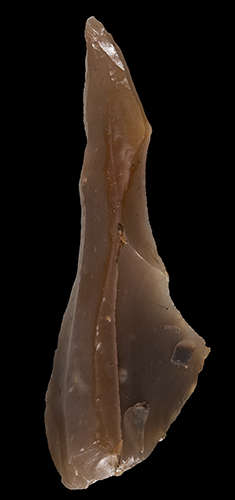
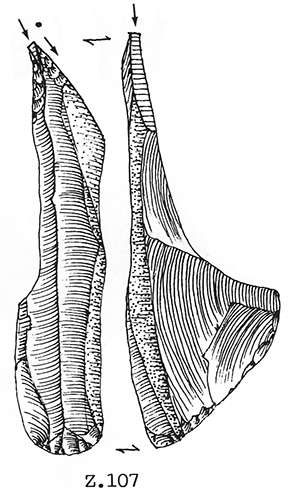
Steker op Beksteker - Burin on Beaked Burin
This is one of the most beautiful of all the tools in the Perdeck Collection.
Length: 61 mm.
Collection: © Maarten Perdeck
Photo (left): © Christophe Brochard
Photo (right): Perdeck (1993)
Drawing: Tekening: Ad Wouters
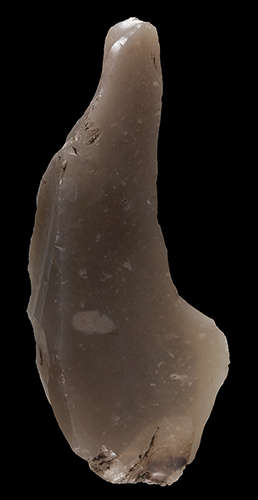
Steker op Beksteker - Burin on Beaked Burin
Length: 37 mm.
Collection: © Maarten Perdeck
Photo: © Christophe Brochard
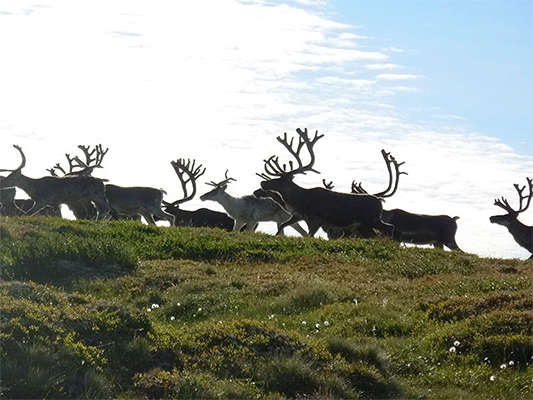
This is the view that the hunters of the Perdeck site strived for - reindeer close by, the wind in the right direction, and an unseen approach!
The Perdeck camp site was on a small, isolated rise. About a kilometre away, there was a nine kilometre long, one kilometre wide ridge running north-south, elevated just five metres above the swampy tundra, but which would have provided both good grazing and an obvious solid, dry path for the reindeer as they travelled to and from their summer pastures.
Photo: © Jeroen van Iddekinge
Source: http://www.treknature.com/gallery/Europe/Norway/photo65128.htm
Dubbele Krombeksteker - Double ended curved tip beaked burin
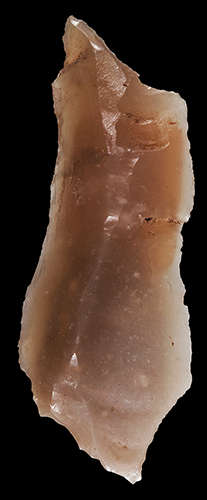
Dubbele Krombeksteker - Double ended curved tip beaked burin
Length: 37 mm.
Collection: © Maarten Perdeck
Photo: © Christophe Brochard
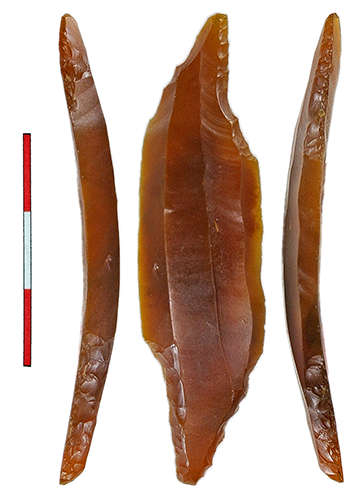
Dubbele Krombeksteker - Double ended curved tip beaked burin from Prandinge.
The krombeksteker is also known under the name Zinke , a German term. According to use-wear and experimental studies, Zinken perforators from Olbrachcice 8 were most probably used as 'scrapers' and 'borers' for antler working, which suggests that they were more or less multifunctional tools. Moreover one implement could have been repeatedly used for similar activity.
Traces of hafting suggest curation – a phenomenon associated with mobile hunting groups. In this case the characteristic curve-shaped tips would be a result of re-sharpening. Thus Zinken perforators may represent formal tools that were used not only for making but essentially for repairing antler weapons.
Photo: Marten, http://archeopedia.nl/index.php?title=Krombeksteker
Text: Baron et al. (2011)
Artefacten uit de Gravette traditie - Tools of the Gravettian tradition
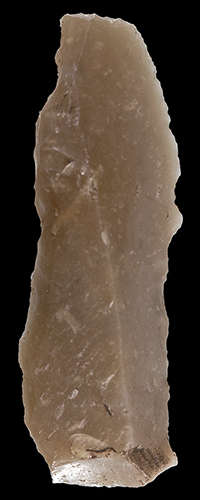

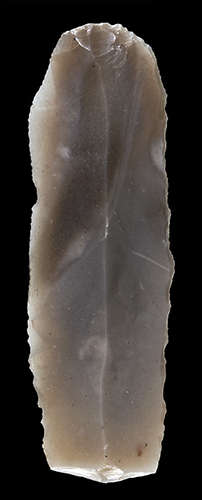
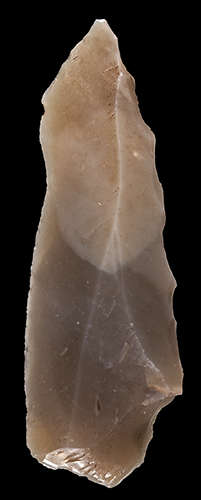
Artefacten uit de Gravette traditie - Tools of the Gravettian tradition.
Lengths left to right: 25 mm, 66 mm, 36 mm, 43 mm.
The diagnostic characteristic artefacts of the industry are small pointed restruck blades with a blunt but straight back, a carving tool known as a Noailles burin, although there are many others.
Collection: © Maarten Perdeck
Photo: © Christophe Brochard
Text: adapted from Wikipedia
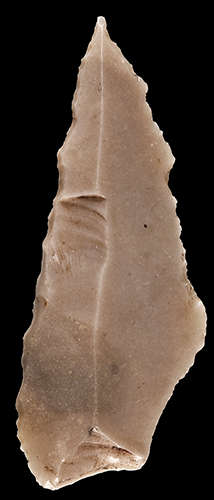


Artefacten uit de Gravette traditie - Tools of the Gravettian tradition.
Lengths left to right: 31 mm, 45 mm, 52 mm.
Collection: © Maarten Perdeck
Photo: © Christophe Brochard
Gekerfde Kling met Fossiel - Notched Blade with Fossil
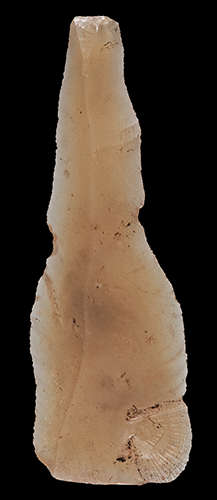
Gekerfde Kling met Fossiel - Notched Blade with Fossil
Length: 37 mm.
Maarten Perdeck writes:
The notched blade with fossil is for me special because it is notched. You could use those notches to attach it to something, as a special ornament.
This fossil appears to be of, or related to, an ancient Cardium shell in the flint of which the blade is made. In this case, it is a negative image of the shell.
The exact mode of formation of flint is not yet clear but it is thought that it occurs as a result of chemical changes in compressed sedimentary rock formations, during the process of diagenesis. One hypothesis is that a gelatinous material fills cavities in the sediment, such as holes bored by crustaceans or molluscs and that this becomes silicified.
This hypothesis certainly explains the complex shapes of flint nodules that are found. The source of dissolved silica in the porous media could be the spicules of silicious sponges. Certain types of flint, such as that from the south coast of England, contain trapped fossilised marine flora. Pieces of coral and vegetation have been found preserved like amber inside the flint. Thin slices of the stone often reveal this effect.
Collection: © Maarten Perdeck
Photo: © Christophe Brochard
Text: adapted from Wikipedia
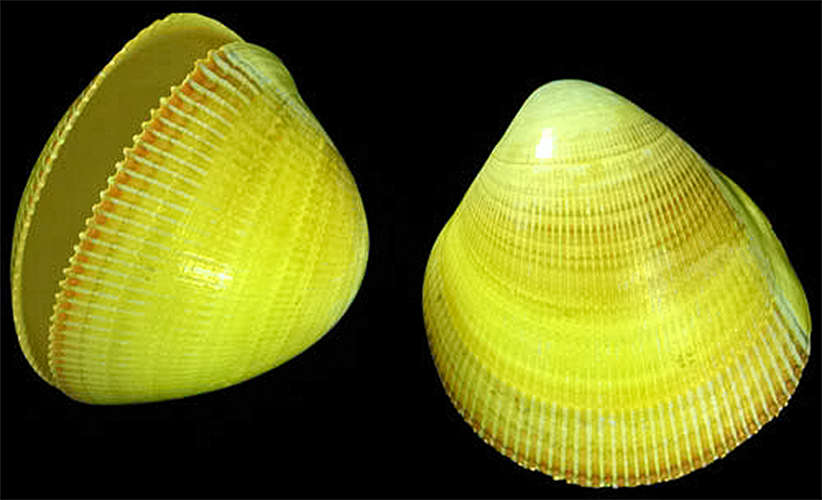
Yellow Cardium shells
Photo: http://www.shells-of-aquarius.com/cardium_shells.html
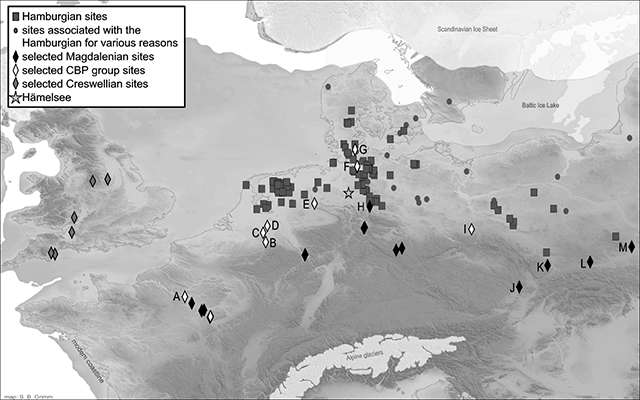
Distribution of the Hamburgian and sites associated with the Hamburgian in early Late glacial north-western Europe. Curve Backed Point (CBP) and Magdalenian sites labelled:
A – Le Closeau
B – Rekem
C – Budel
D - Milheeze-Hogeloop
E – Westerkappeln
F – Klein-Nordende
G - Alt Duvenstedt
H – Gadenstedt
I - Reichwalde,
J - Pekárna Cave
K - Dzierżysław 35
L - Maszycka Cave
M - Wilczyce
Photo and text: Grimm and Weber (2008)
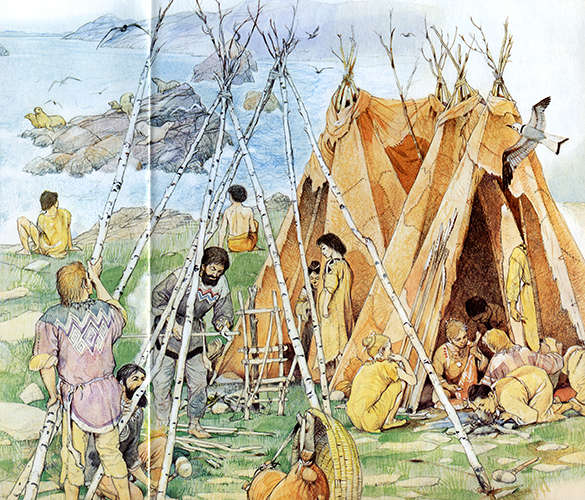
On arrival at the summer camp site, which was often the same site as previous years, if the reindeer kept to their traditional path, the hunters erected their tents. If it was in the nearly treeless tundra, near the eternal ice, as was normal, they would have had to have taken the poles for the tents with them, perhaps using them lashed together and dragged behind the trudging men, doing double duty in holding their heavy loads of supplies for the journey, as well as clothes, weapons and tools. When they had served this purpose, they were reused for tent poles.
The camp site was always near a supply of fresh water, and in the confused drainage of the tundra, this was always available in the form of lakes which were ice free in the summer, and which provided a convenient place ( human nature has not changed much, after all! ) to toss all their defleshed bones, unwanted antlers, broken tools, and other rubbish, keeping the campsite itself clean and wholesome - a godsend for archaeologists many thousands of years later.
The first task on arrival was to make a fire, achieved by striking flint on a piece of pyrites, or marcasite, with the resultant sparks falling onto finely pounded willow bark, dried moss, or a fungus such as Fomes fomentarius. The embers thus created were then quickly blown into a fire with fine tinder, then larger diameter wood was added to get the campfire burning well.
Even in the tundra small trees sometimes grow in sheltered positions, but fuel would always have been a problem in these areas. Bone will burn, especially if it is old, dry bone, but it is not an ideal fuel, and is best used in conjunction with whatever wood can be scavenged (Äikäs et al., 2010).
This beautiful art work created by Giovanni Caselli shows them, however, camped beside the sea. Out of sight but close at hand would have been a convenient brook for fresh water.
Photo and text: Adapted from Caselli (1985)
Klingen - Blades
In archaeology a blade is a type of stone tool created by striking a long narrow flake from a stone core. Blades are defined as being flakes that are at least twice as long as they are wide and that have parallel or subparallel sides.Text above: adapted from Wikipedia
Additionally, a tool must be part of an intentional blade industry in order to properly be considered a blade; tools which show the characteristics of blades through variation but are not intentionally produced with those characteristics are not considered true blades. Blades became the favoured technology of the Upper Palaeolithic era, although they are occasionally found in earlier periods.
A soft punch or hammerstone is necessary in creating a blade and their long sharp edges made them useful for a variety of purposes. They were often worked to create scrapers or burins.
Blade Core Technique
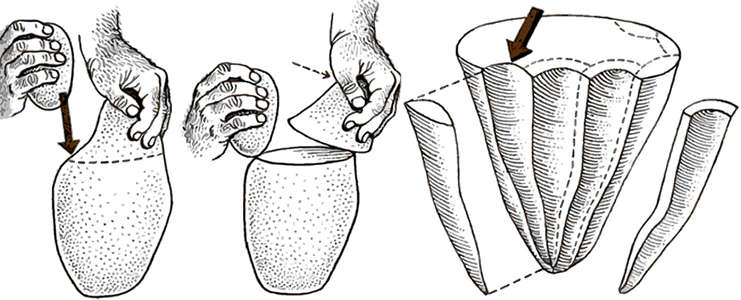
A core for many blades is prepared by breaking a large flint nodule in two with a hammerstone. Using either piece, the maker then knocks long, thin flakes from the outside rim leaving a tapering fluted core. From this he produces a whole series of finished blades, striking them off one by one as he spirals around the nucleus.
By striking between ridges he will get a hollowed blade (top right). It has been estimated that a two-pound nucleus, flaked in this fashion, will yield some 25 yards of working edge, whereas a hand-axe shaped from the same stone would yield about four inches of effective edge.
Photo and text: Howell (1965), drawings by Lowell Hess.


Klingen - Blades.
Lengths: 66 mm, 64 mm.
Collection: © Maarten Perdeck
Photo: © Christophe Brochard

Kling met Kerf - Blade with Notch
Length: 58 mm.
Collection: © Maarten Perdeck
Photo: © Christophe Brochard
Klingschrabbers - Scrapers made on a blade
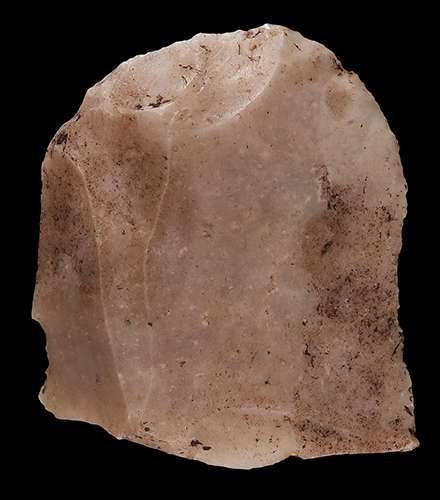
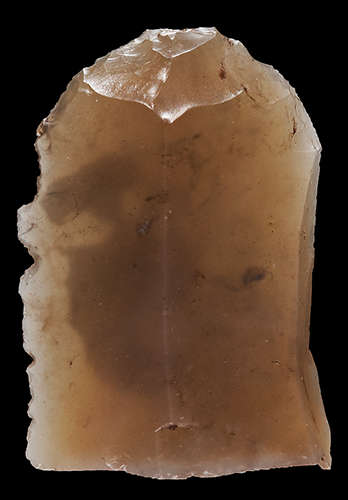
Klingschrabbers - Scrapers made on a blade.
Lengths left to right: 18 mm, 20 mm.
Collection: © Maarten Perdeck
Photo: © Christophe Brochard
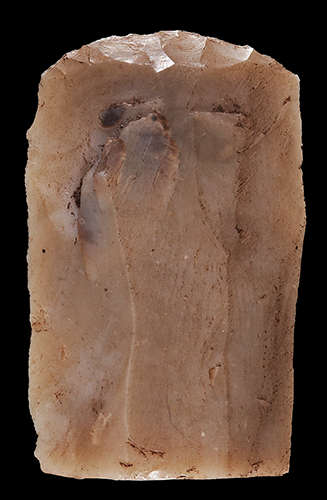
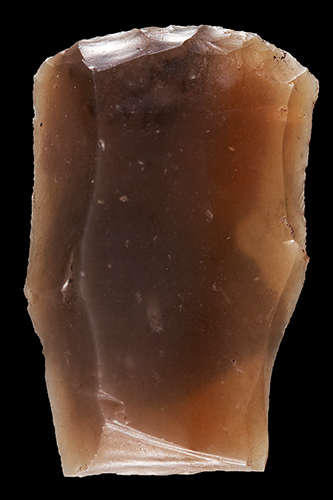
Klingschrabbers - Scrapers made on a blade.
Lengths left to right: 21 mm, 25 mm.
Collection: © Maarten Perdeck
Photo: © Christophe Brochard


Klingschrabbers - Scrapers made on a blade.
Lengths left to right: 26 mm, 27 mm.
Collection: © Maarten Perdeck
Photo: © Christophe Brochard
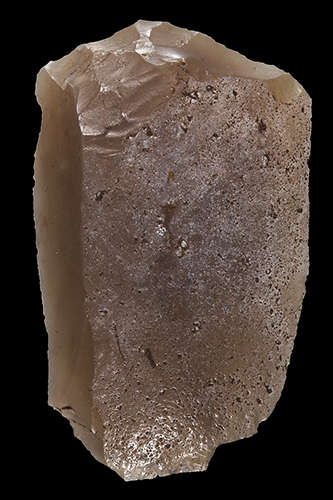
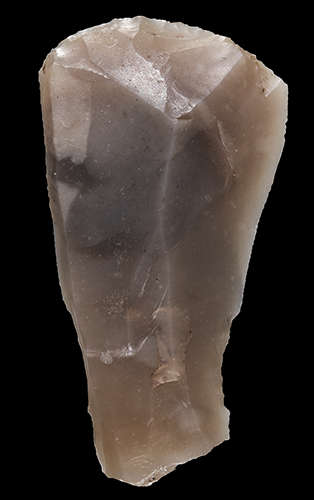
Klingschrabbers - Scrapers made on a blade.
Lengths left to right: 28 mm, 28 mm.
Collection: © Maarten Perdeck
Photo: © Christophe Brochard
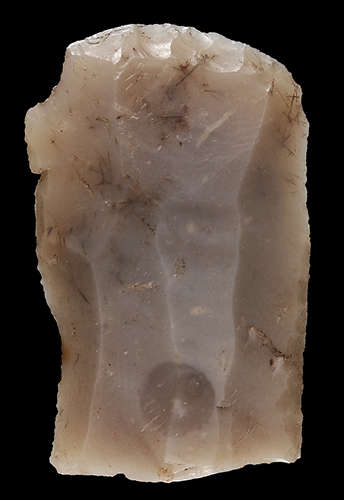
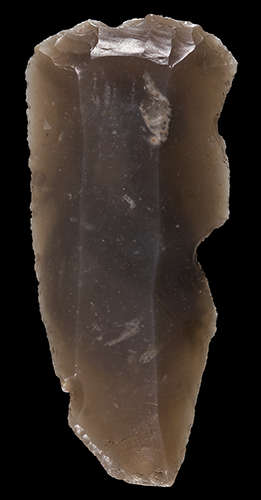
Klingschrabbers - Scrapers made on a blade.
The scraper on the left has inclusions of many very small black Sea Urchin spines.
Lengths left to right: 28 mm, 39 mm.
Collection: © Maarten Perdeck
Photo: © Christophe Brochard
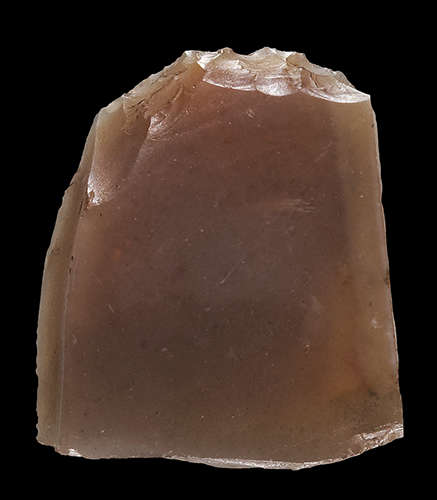
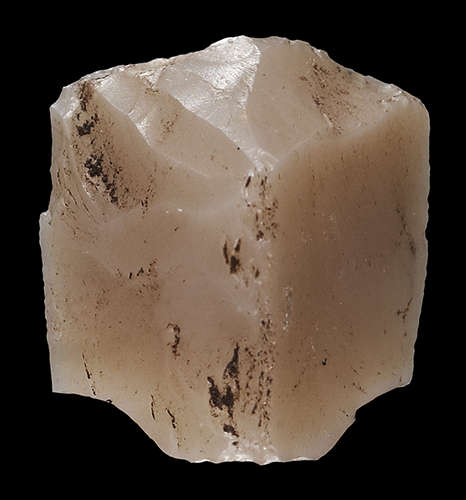
Klingschrabbers - Scrapers made on a blade.
Lengths left to right: 14 mm, 12 mm.
Collection: © Maarten Perdeck
Photo: © Christophe Brochard
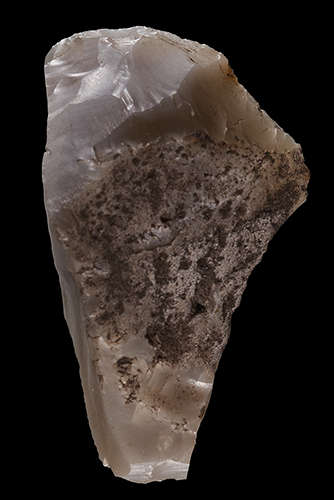

Klingschrabbers - Scrapers made on a blade.
Lengths left to right: 31 mm, 31 mm.
Collection: © Maarten Perdeck
Photo: © Christophe Brochard
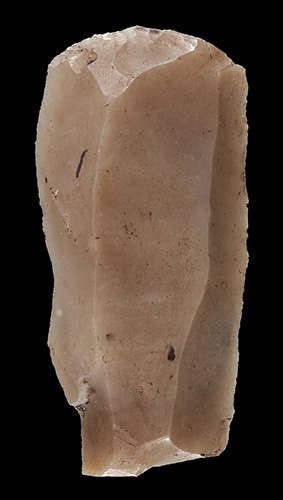
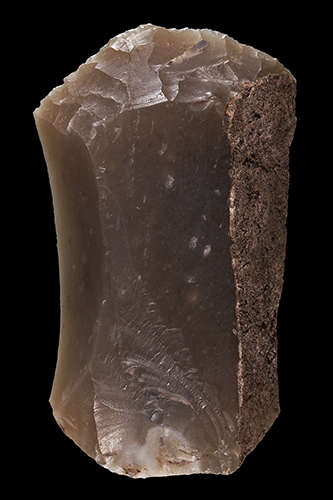
Klingschrabbers - Scrapers made on a blade.
Lengths left to right: 32 mm, 33 mm.
Collection: © Maarten Perdeck
Photo: © Christophe Brochard
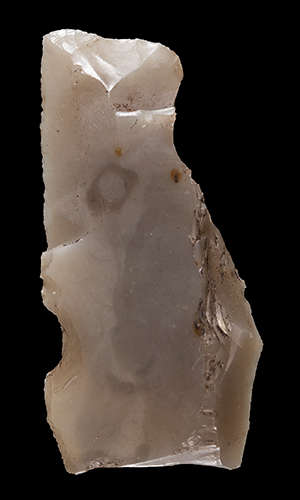
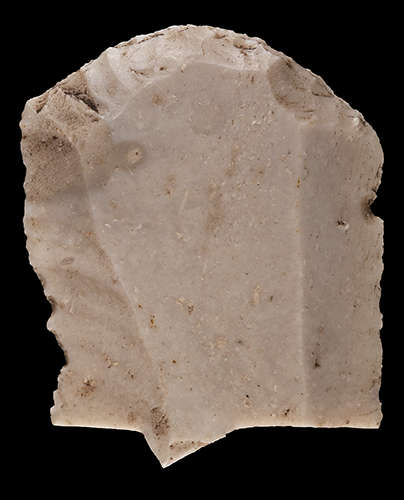
Klingschrabbers - Scrapers made on a blade.
Lengths left to right: 33 mm, 33 mm.
Collection: © Maarten Perdeck
Photo: © Christophe Brochard
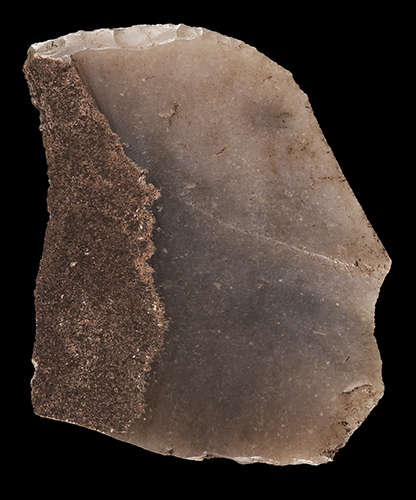
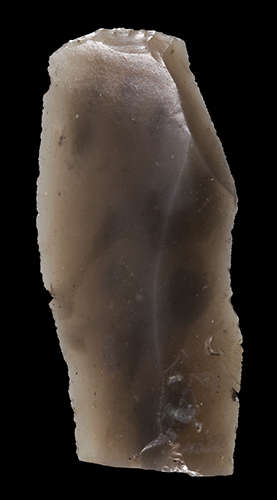
Klingschrabbers - Scrapers made on a blade.
Lengths left to right: 34 mm, 34 mm.
Collection: © Maarten Perdeck
Photo: © Christophe Brochard
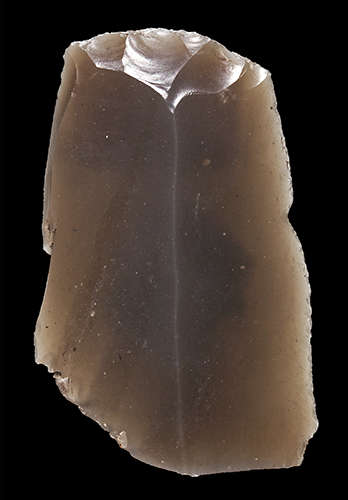
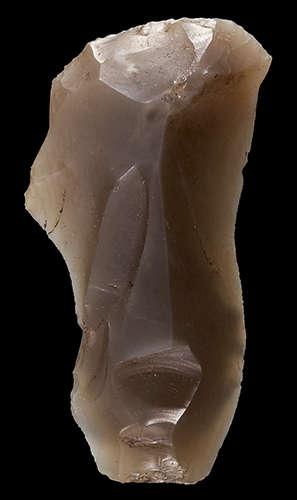
Klingschrabbers - Scrapers made on a blade.
Lengths left to right: 34 mm, 35 mm.
Collection: © Maarten Perdeck
Photo: © Christophe Brochard
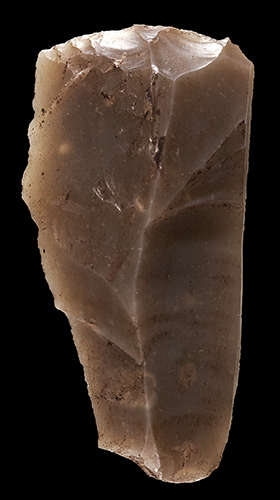
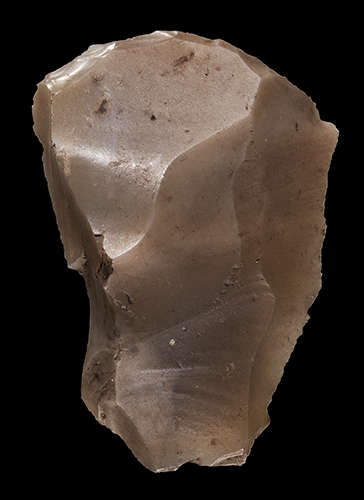
Klingschrabbers - Scrapers made on a blade.
Lengths left to right: 36 mm, 36 mm.
Collection: © Maarten Perdeck
Photo: © Christophe Brochard
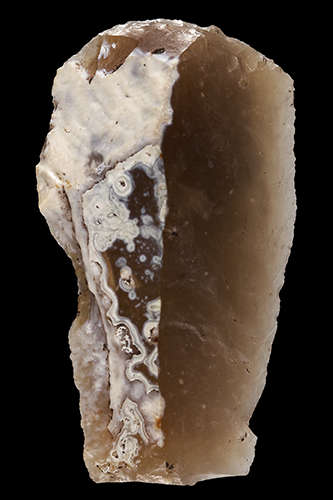
Klingschrabber - Scraper made on a blade.
This superb artefact has an agate-like pattern on the cortex. This is most unusual.
Length: 36 mm.
Collection: © Maarten Perdeck
Photo: © Christophe Brochard
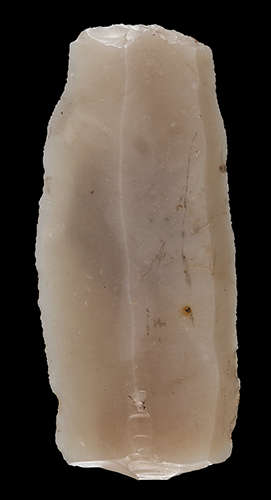
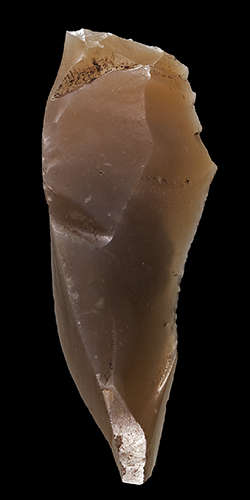
Klingschrabbers - Scrapers made on a blade.
Lengths left to right: 36 mm, 39 mm.
Collection: © Maarten Perdeck
Photo: © Christophe Brochard
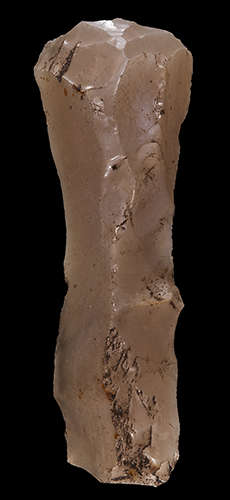
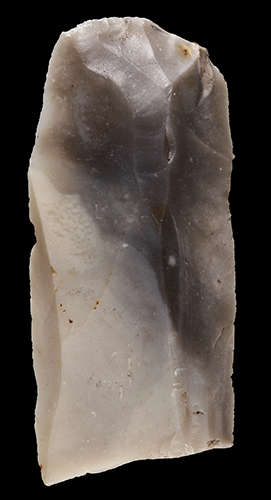
Klingschrabbers - Scrapers made on a blade.
Lengths left to right: 40 mm, 42 mm.
Collection: © Maarten Perdeck
Photo: © Christophe Brochard
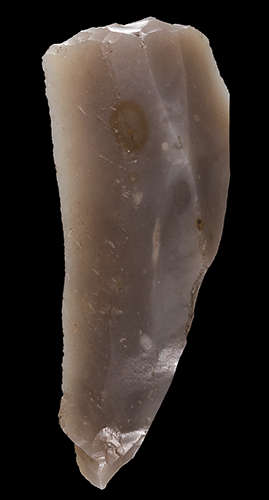
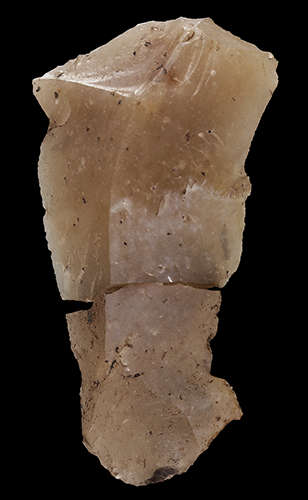
Klingschrabbers - Scrapers made on a blade.
Lengths left to right: 42 mm, 43 mm.
Collection: © Maarten Perdeck
Photo: © Christophe Brochard
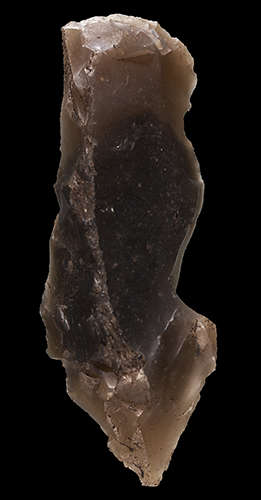
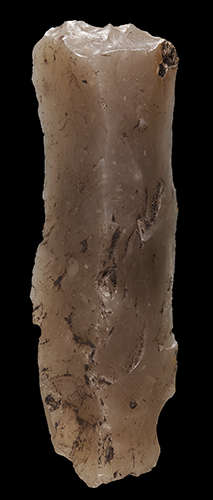
Klingschrabbers - Scrapers made on a blade.
Lengths left to right: 50 mm, 51 mm.
Collection: © Maarten Perdeck
Photo: © Christophe Brochard
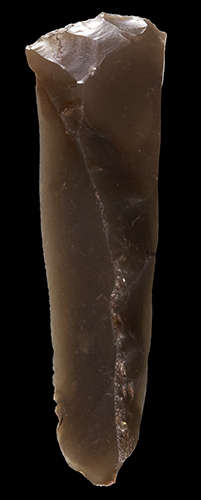
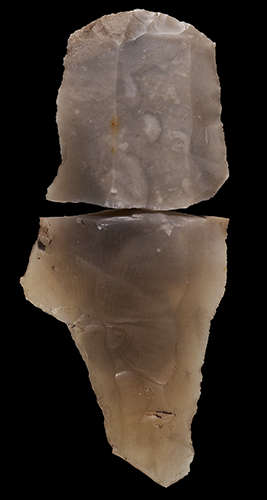
Klingschrabbers - Scrapers made on a blade.
Lengths left to right: 54 mm, 56 mm.
Collection: © Maarten Perdeck
Photo: © Christophe Brochard
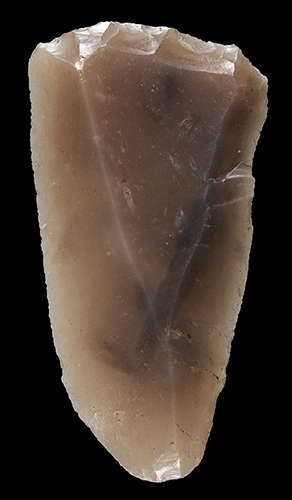
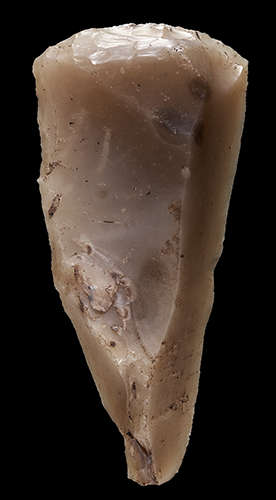
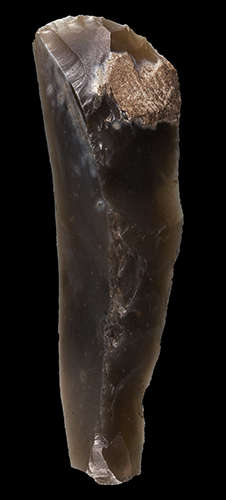
Klingschrabbers - Scrapers made on a blade.
Lengths left to right: 31 mm, 47 mm, 48 mm.
Collection: © Maarten Perdeck
Photo: © Christophe Brochard
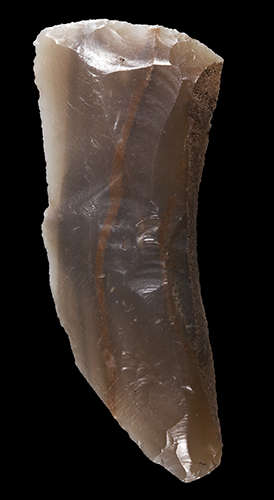
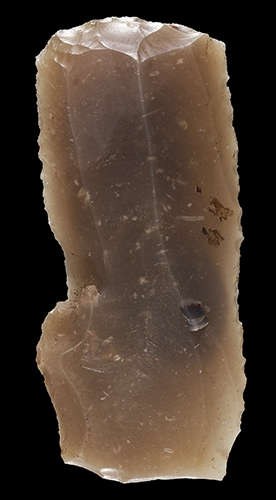

Klingschrabbers - Scrapers made on a blade.
Lengths left to right: 42 mm, 37 mm, 35 mm.
Collection: © Maarten Perdeck
Photo: © Christophe Brochard
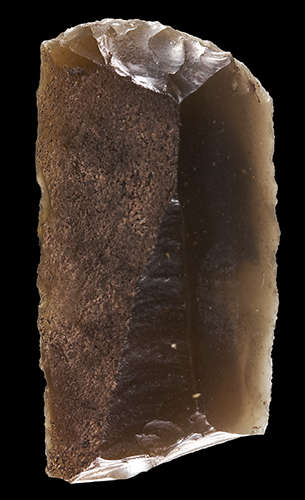
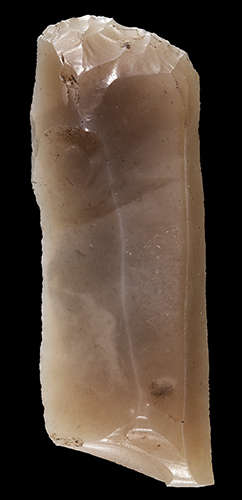
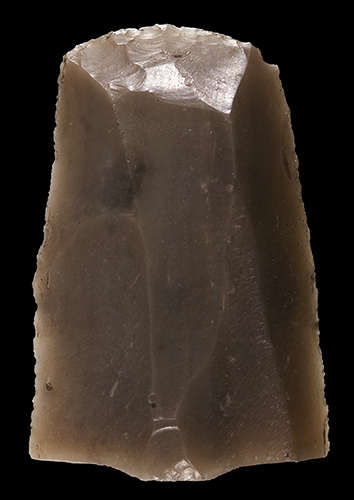
Klingschrabbers - Scrapers made on a blade.
Lengths left to right: 30 mm, 34 mm, 23 mm.
Collection: © Maarten Perdeck
Photo: © Christophe Brochard
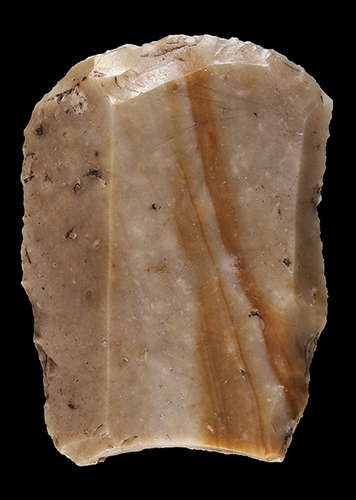
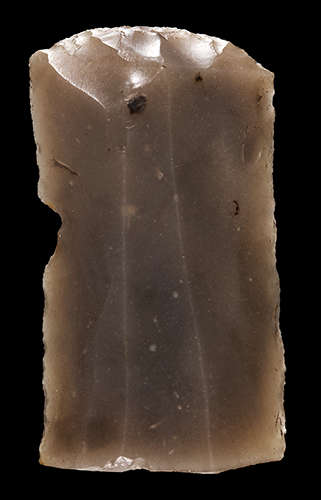
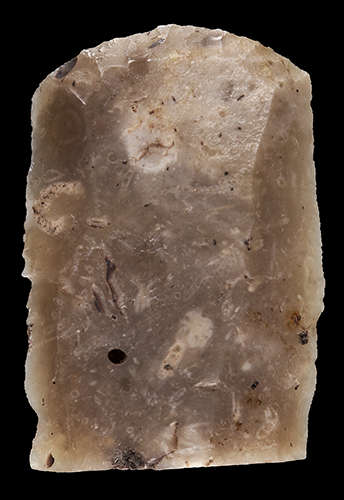
Klingschrabbers - Scrapers made on a blade.
The tool on the right is packed with fragments of fossils, including some showing the network structure of sponges or corals.
Lengths left to right: 29 mm, 28 mm, 33 mm.
Collection: © Maarten Perdeck
Photo: © Christophe Brochard
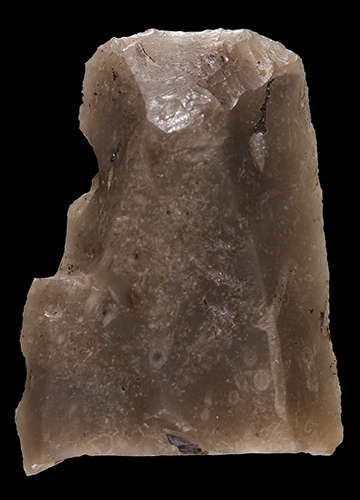
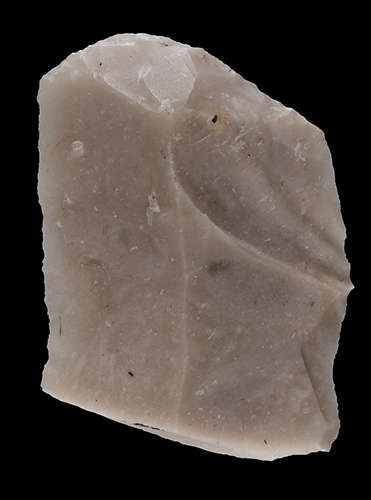
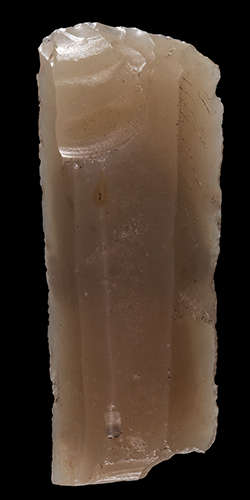
Klingschrabbers - Scrapers made on a blade.
Lengths left to right: 27 mm, 27 mm, 28 mm.
Collection: © Maarten Perdeck
Photo: © Christophe Brochard
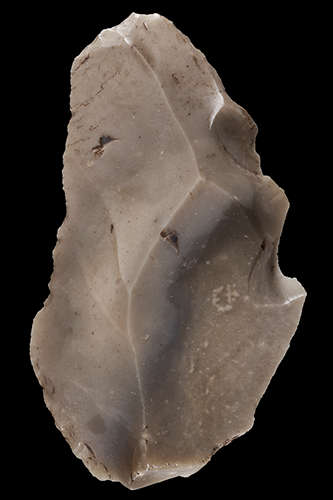
Scheve Klingschrabber - Crooked Scraper made on a blade.
Length: 59 mm.
Collection: © Maarten Perdeck
Photo: © Christophe Brochard
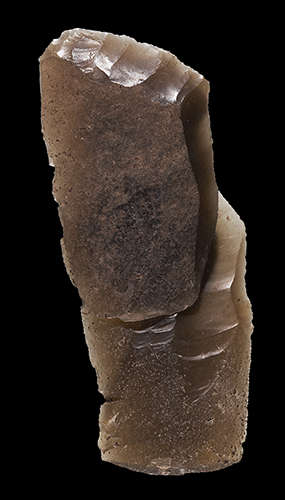
Klingschrabber met joint - Scraper made on a blade, refitted to the blade it was struck from.
Length: 47 mm.
Collection: © Maarten Perdeck
Photo: © Christophe Brochard
Klingschrabbers Met Stekers - Scrapers made on a blade, combined with a burin added to the other end of each tool
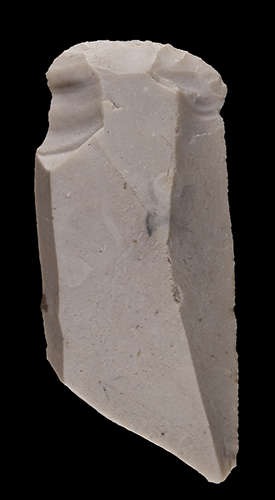
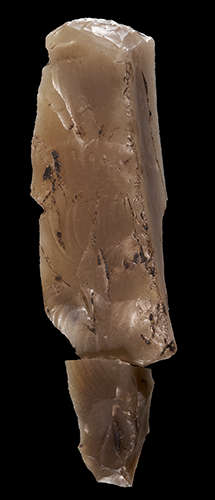
Klingschrabbers Met Stekers - Scrapers made on a blade, combined with a burin added to the other end of each tool.
Lengths left to right: 41 mm, 59 mm.
Collection: © Maarten Perdeck
Photo: © Christophe Brochard
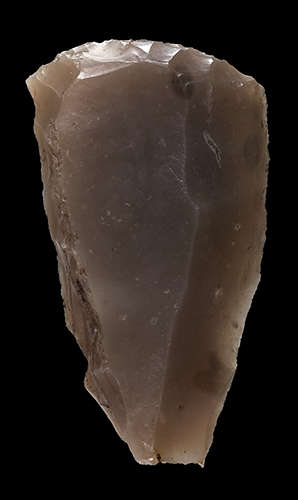
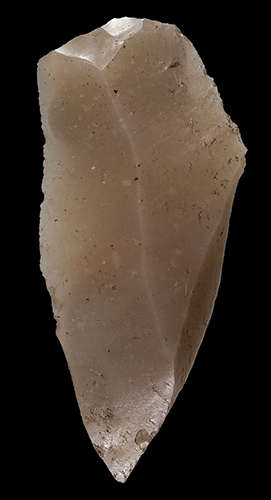
Klingschrabbers Met Stekers - Scrapers made on a blade, combined with a burin added to the other end of each tool.
Lengths left to right: 35 mm, 35 mm.
Collection: © Maarten Perdeck
Photo: © Christophe Brochard
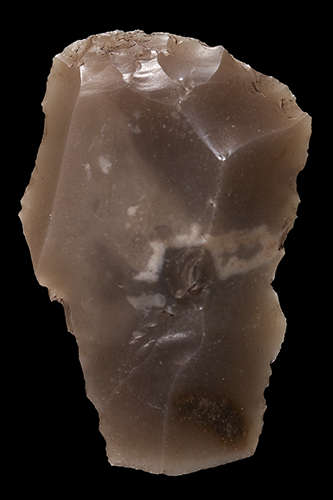
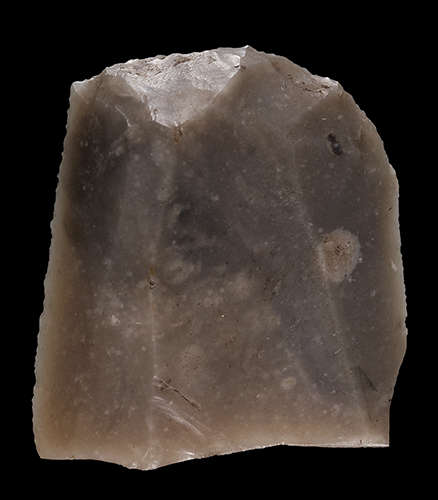
Klingschrabbers Met Stekers - Scrapers made on a blade, combined with a burin added to the other end of each tool.
Lengths left to right: 38 mm, 21 mm.
Collection: © Maarten Perdeck
Photo: © Christophe Brochard
Klingschrabber Met Holle Schrabber - Scraper made on a blade with the addition of a hollow or concave scraper to the other end

Klingschrabber Met Holle Schrabber - Scraper made on a blade with the addition of a hollow or concave scraper to the other end.
This tool has many fragments of fossils embedded in the matrix.
Length: 57 mm.
Collection: © Maarten Perdeck
Photo: © Christophe Brochard
Klingschrabbers met RA Stekers - Scrapers made on a blade, combined with a 'blunted burin' added to the other end of each tool.

Klingschrabber met RA Steker - Scraper made on a blade, combined with a blunted burin added to the other end of the tool.
Length: 35 mm.
This was the first tool discovered by Maarten Perdeck. He discovered the site when he worked for a local city, in the outdoors maintenance department.
Maarten writes:
One summer day I dragged my bicycle up a hill on a sandy road. When I reached the top (once Hamburg hunters did the same) I walked in the fully grown maize field beside the road. Blades! a big bladecore, and the first real tool.
This is still the most beautiful artefact I have discovered. It is made of the best black flint, the lateral sides finely retouched (as many blade scrapers are, but usually too finely to show up in a photo), a spot of that mysterious high gloss, and a perfect scraper (perfect is for me a very sharp angle).
This scraper has the sharpest scraper-angle of them all. It is made by a special technique. The blade-end where the scraper is planned is put on an anvil, resting on the dorsal rib, then carefully and repeatedly hit with a hammerstone. On the photo you can see that the dorsal rib is blunted because of this process.
When I examined the other end I thought I saw just another scraper, but much cruder. OK, a double scraper, but looking more closely I saw that several small 'blades' were cut off. Why 'destroy' such a nice tool? Prehistoric hooligans? Later I learned that the 'damage' was a burin, and the opposite supposed scaper was just the platform for the burin.
I learned much, including these things, from my mentor, Ad Wouters, who once worked with Breuil.
Collection: © Maarten Perdeck
Photo: © Christophe Brochard
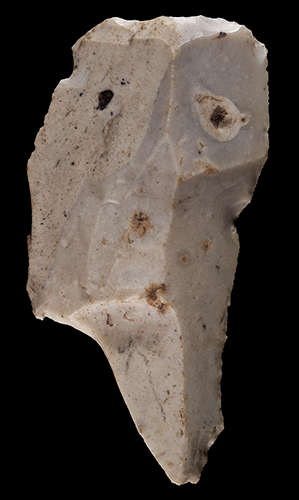
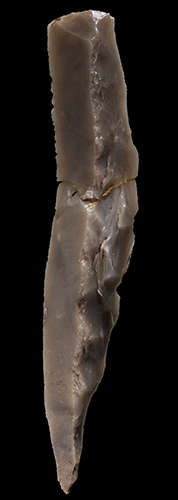
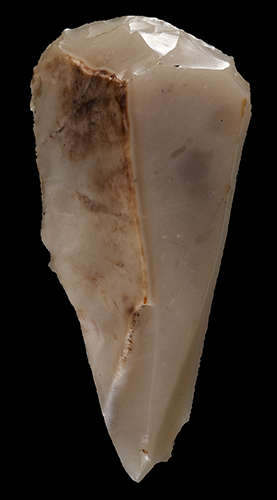
Klingschrabbers met RA Stekers - Scrapers made on a blade, combined with a blunted burin added to the other end of each tool.
Lengths, left to right: 48 mm, 77 mm, 42 mm.
Collection: © Maarten Perdeck
Photo: © Christophe Brochard
Dubbele Klingschrabbers - Double Scrapers made on a blade
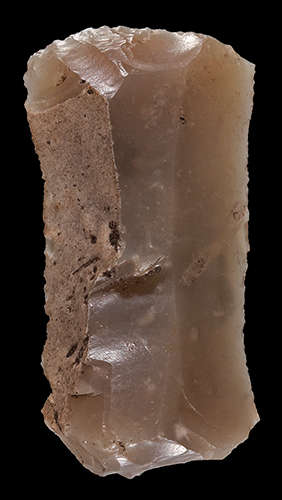
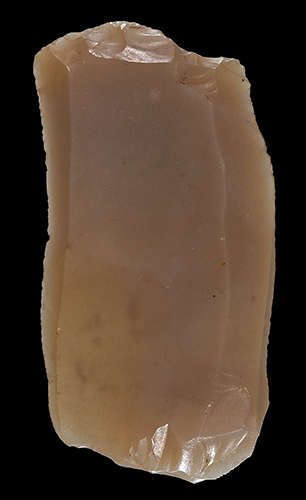
These are double scrapers, Dubbele Klingschrabbers, with a scraper on each end of the blade.
Lengths left to right: 30 mm, 37 mm.
Collection: © Maarten Perdeck
Photo: © Christophe Brochard
Holle Klingschrabber - Concave Scraper on a Blade
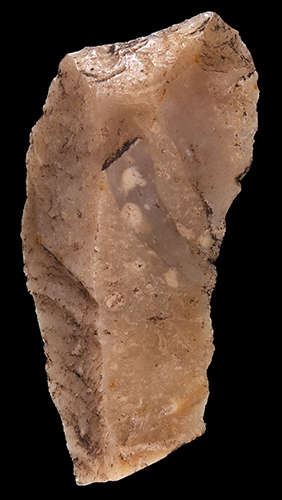
Holle Klingschrabber - Concave or Hollow Scraper on a Blade.
The Hollow Scraper is a type of scraper that has a notch worked into the side or end of the scraper.
Length 52 mm.
Collection: © Maarten Perdeck
Photo: © Christophe Brochard
Text: Adapted from Wikipedia
Korte Schrabbers - Short Scrapers
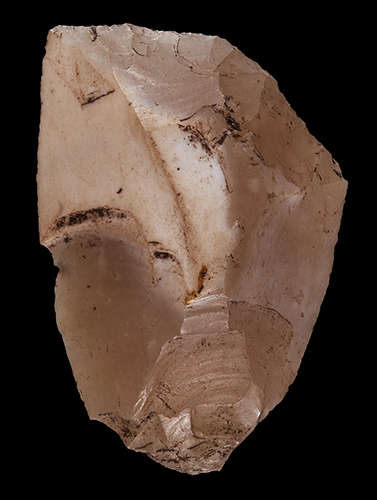
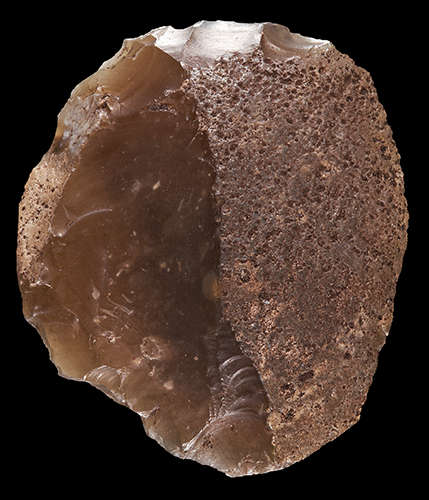
Korte Schrabber - Short Scraper.
Lengths left to right: 24 mm, 35 mm.
Collection: © Maarten Perdeck
Photo: © Christophe Brochard
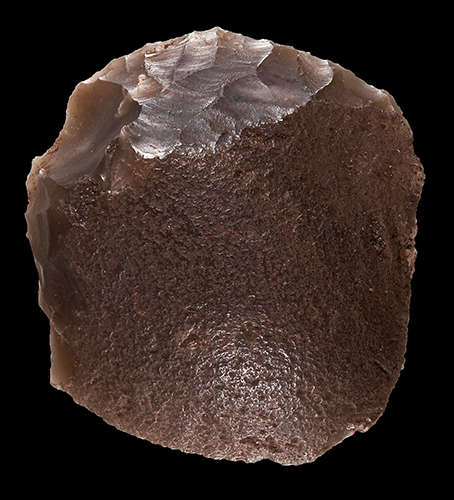

Korte Schrabbers - Short Scrapers.
Note that both of these blades were among the first to be struck from the core, since they still show evidence of the outer layer of the flint nodule.
The silica material of flint is probably derived from the siliceous spicules of sponges and microscopic siliceous plankton, which are slightly soluble in water, so some of it dissolved in the ocean and was later precipitated out onto the chalk sea bed. Often it collected around some solid object such as a sponge or coral, and these are sometimes visible inside the flint when a nodule is broken open.
It is thought that initially, the silica must have gone through a gel-like phase before hardening into flint, because it is found completely filling shells such as those of sea urchins.
Flint nodules typically form in chalk, and changed over time as their outside acquired a whitish-coloured cortex or rind, possibly through ground water percolating through the chalk. It is thought the cortex formed because the flint surface is slightly more soluble in some microscopically small areas than in adjacent areas, so there is differential dissolving at the surface which results in a microscopic sponge-like structure. The cortex can be 5mm or more in thickness.
When people started making tools from flint, they often removed the external cortex to get at the fresh flint inside, although in some cases they left a small amount of cortex to make some tools, such as scrapers and knives, easier to handle.
In the case of the scraper on the left, this outside layer is shown by the rough and pitted surface, and the one on the right still shows part of the cortex, the outside layer of the flint pebble. Although it looks like chalk, and can sometimes be scraped away as a powder, it is not chalk, but quartz, since it cannot be dissolved in acids.
Lengths left to right: 21mm, 26 mm.
Collection: © Maarten Perdeck
Photo: © Christophe Brochard
Text: adapted from http://www.quartzpage.de/flint.html and http://www.stoneagetools.co.uk/what-is-flint.htm
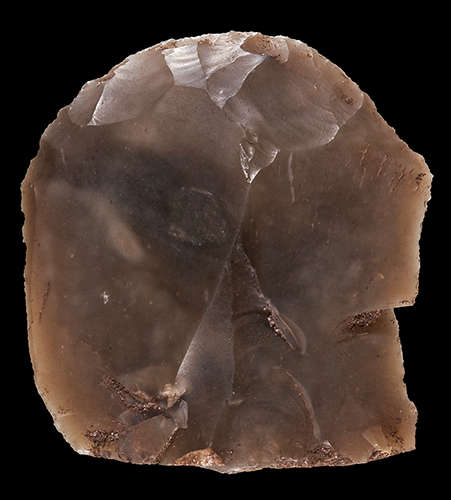
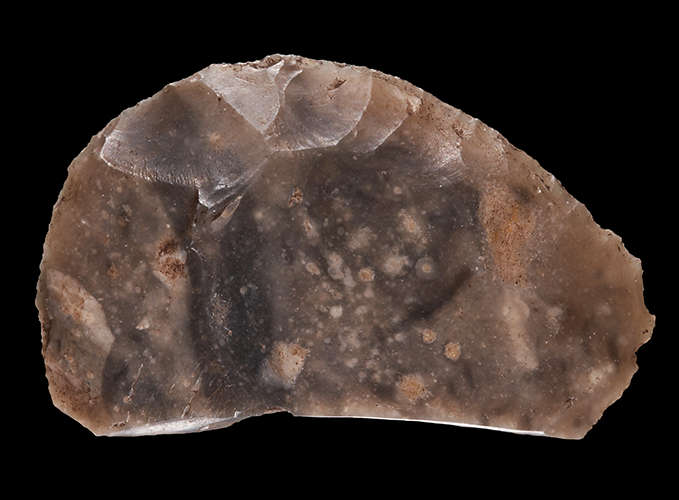
Korte Schrabbers - Short Scrapers.
Lengths left to right: 27 mm, 29 mm.
Collection: © Maarten Perdeck
Photo: © Christophe Brochard
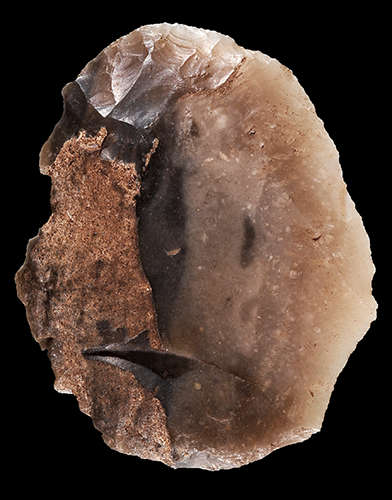
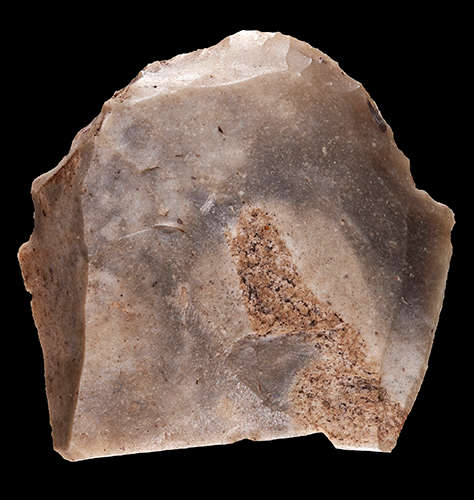
Korte Schrabbers - Short Scrapers.
Lengths left to right: 37 mm, 35 mm.
Collection: © Maarten Perdeck
Photo: © Christophe Brochard
Text: Adapted from Wikipedia

Korte Schrabber Verbrand - Burnt Short Scraper.
Length: 23 mm.
Collection: © Maarten Perdeck
Photo: © Christophe Brochard

Korte Schrabber met Geode - Short Scraper with Geode.
Geodes are hollow structures in some sedimentary and volcanic rocks which are later partially or completely filled with crystals precipitated from fluids which enter the vesicle.
This geode shows some beautiful tiny crystals of, presumably, quartz, and no doubt was a valued tool because of its beauty.
Length: 35 mm.
Collection: © Maarten Perdeck
Photo: © Christophe Brochard
Text: Adapted from Wikipedia
Dubbele Schrabbers - Double Scrapers
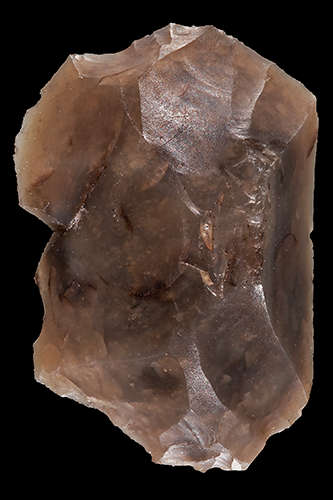
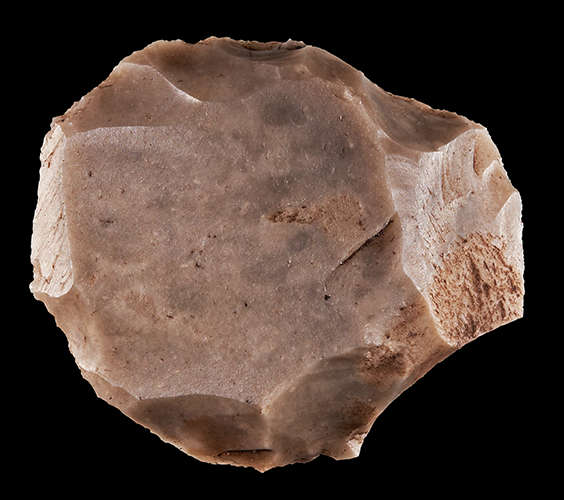
Dubbele Schrabbers - Double Scrapers
Lengths left to right: 16 mm, 24 mm.
Collection: © Maarten Perdeck
Photo: © Christophe Brochard
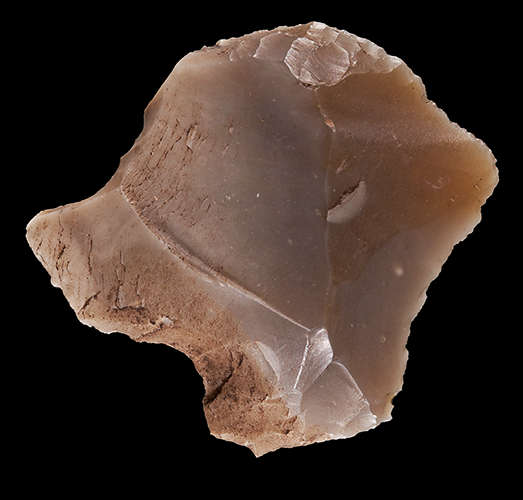
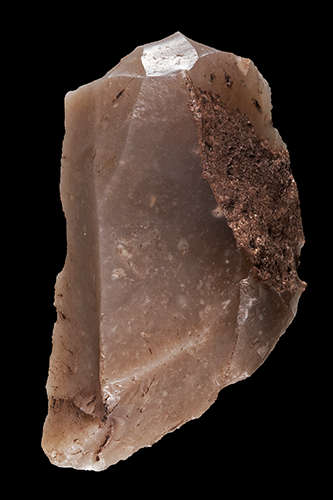
Dubbele Schrabbers - Double Scrapers
Lengths left to right: 30 mm, 30 mm.
Collection: © Maarten Perdeck
Photo: © Christophe Brochard
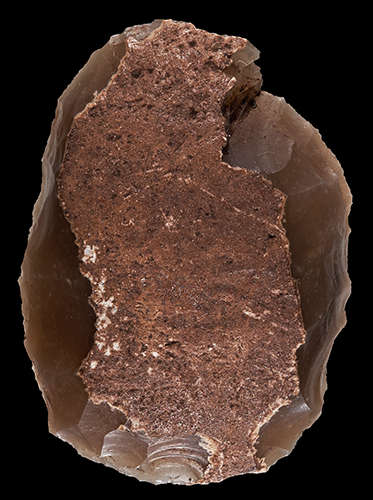

Dubbele Schrabbers - Double Scrapers
Lengths left to right: 27 mm, 33 mm.
Collection: © Maarten Perdeck
Photo: © Christophe Brochard
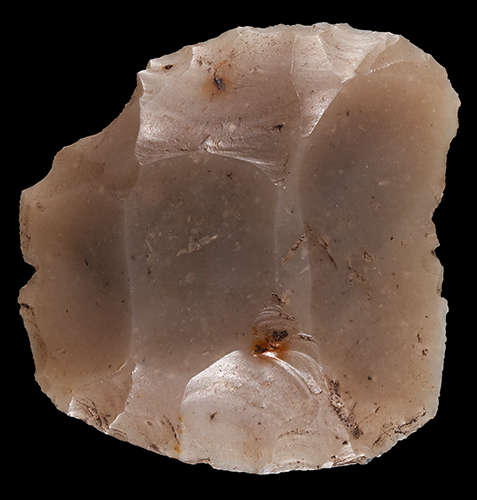

Dubbele Schrabbers - Double Scrapers
Lengths left to right: 30 mm, 34 mm.
Collection: © Maarten Perdeck
Photo: © Christophe Brochard

Dubbele Schrabber Verbrand - Burnt Double Scraper
Length: 16 mm.
Collection: © Maarten Perdeck
Photo: © Christophe Brochard
Bekschrabber - Beaked Scraper - Grattoir à Bec
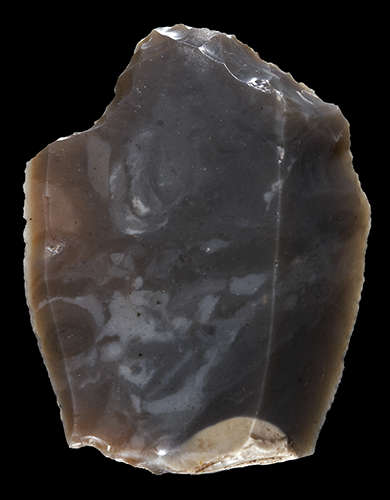
Bekschrabber - beaked scraper. length 38 mm.
This is a fairly rare form of scraper, a flint flake with a point like a beak. Either the convex or the concave side of the beak may be used for scraping. The beaked scraper is also known as a grattoir à bec, or grattoir-bec.
Collection: © Maarten Perdeck
Photo: © Christophe Brochard
Text: Winick (1956)
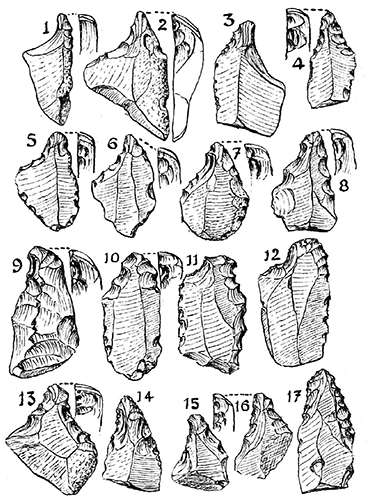
Various Grattoirs-becs.
Photo and text: Delarue et Vignard (1959)
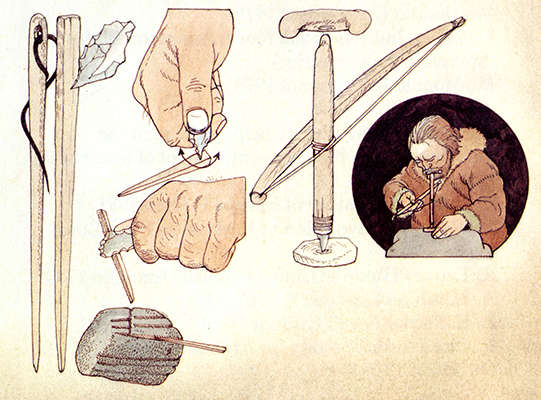
Drills were used as hand held tools and also hafted onto a handle to make them easier to use. Fine drills at the limit of the technology were needed to make holes in bone or antler needles to make the sewing of clothes easier. After the needles were created by scoring antler, the needles had a hole drilled in them, and were then fined down and rounded in grooves on pebbles of sandstone.
Photo: Caselli (1985)
Boren - Drills
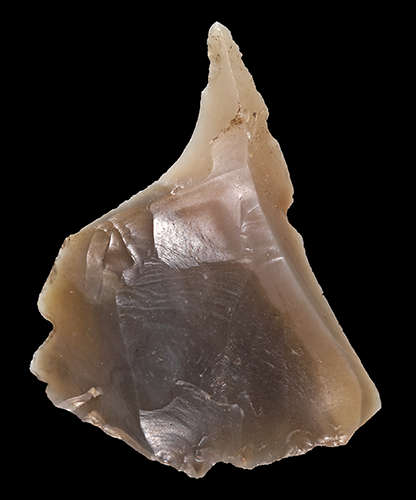
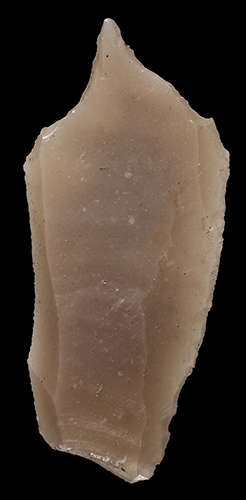
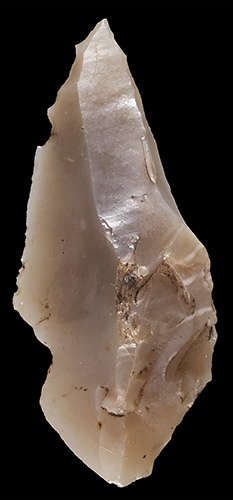
Boren - Drills - Perçoirs
Lengths left to right: 33 mm, 37 mm, 49 mm.
Collection: © Maarten Perdeck
Photo: © Christophe Brochard
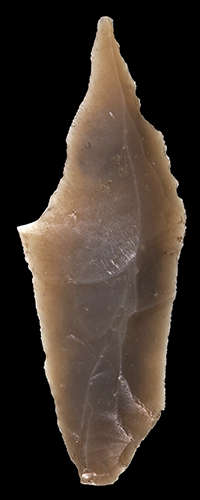
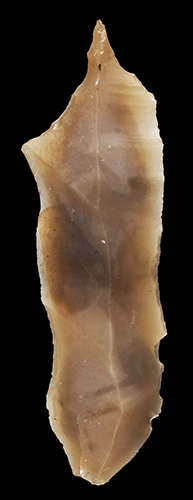
Boren - Drills.
Lengths left to right: 48 mm, 49 mm.
Note that the lateral 'points' on these tools have no retouch nor wear, so they are just 'natural' parts of the blades, occurring as part of the knapping process.
Collection: © Maarten Perdeck
Photo: © Christophe Brochard
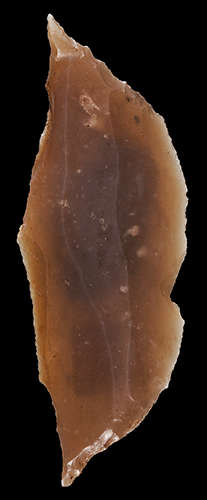
Dubbele Boor - Drill with a point at each end.
Length: 52 mm.
Collection: © Maarten Perdeck
Photo: © Christophe Brochard
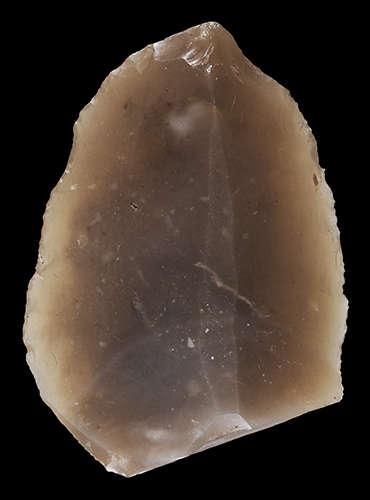
Boor met sterk afgesleten punt - Drill with badly worn point, length 35 mm.
Collection: © Maarten Perdeck
Photo: © Christophe Brochard
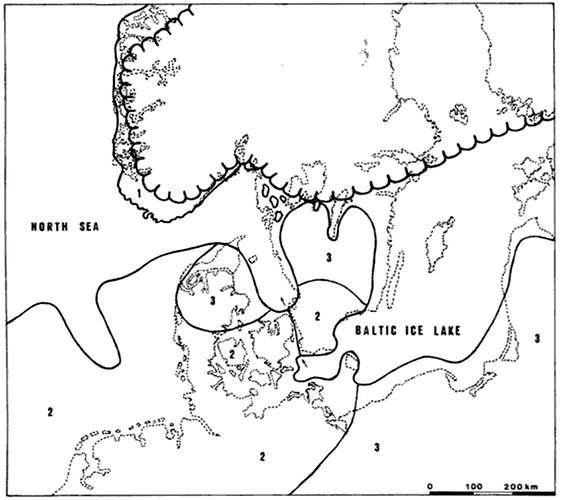
South Scandinavian land and sea configuration in Dryas III (ice margin at 10 000 BP)
1 - Tundra
2 - Park-Tundra with birch groves
3 - Sparse birch and pine forests
Readers may be interested in the dying stages of the last ice age, when reindeer hunters moved north onto the Scandinavian peninsula following the herds, in the process learning how to follow them across the fiords, and to invent the skin boats and adaptations of the spear and harpoon hunting tool kit necessary for this process, which then allowed them access to a hitherto untapped biome of fish and marine mammals.
This map shows the Baltic Ice Lake just before it joined with the North Sea, and the Vegetation Zones which were extant at that time.
Photo: Straus (1996)
Joint - Refitting flakes and blades back onto the original core or nucleus to determine the knapping sequence
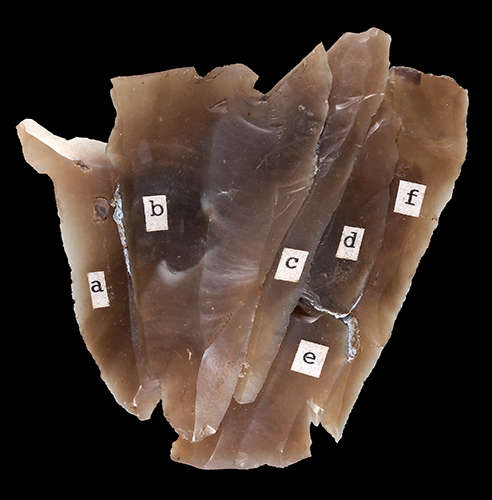
Joint - Refitting flakes and blades back onto the original core to determine the knapping sequence.
Here several scrapers on blades have been refitted to the original core.
Length 58 mm.
Collection: © Maarten Perdeck
Photo: © Christophe Brochard
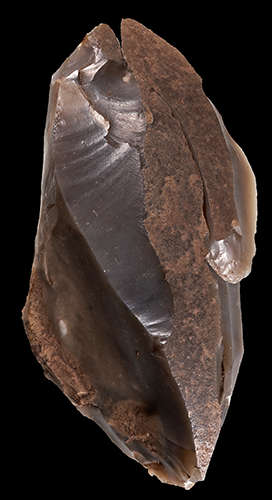
Joint - Refitting flakes and blades back onto the original core or nucleus to determine the knapping sequence.
In this case a scraper on a blade has been refitted to its core.
Length 76 mm.
Collection: © Maarten Perdeck
Photo: © Christophe Brochard
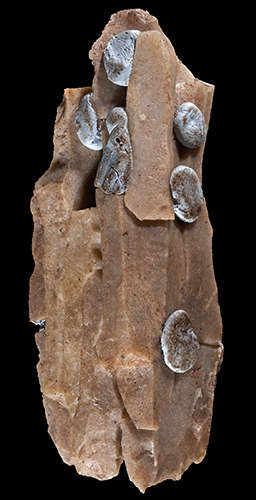
Maarten Perdeck writes:
Joint - This is the biggest joint, of grey flint, and does not contain scrapers, only blades and fragments.
Once I constructed 2 separate joints from this grey flint. For weeks it all was in Ad Wouters' house for drawing, and many, many collectors visited him and of course they all handled my finds. When I got all the finds back home I experienced a magical moment, when with one simple move I connected the 2 joints together into one!
The best conditions for searching on such a field are fresh worked soil and rain. Of course I could not always wait for that, so in the dark I went to the site and worked the soil with a gardening tool. Doing so once I heard a 'kling' and feeling in total darkness I found a blade!
Length 92 mm.
Collection: © Maarten Perdeck
Photo: © Christophe Brochard
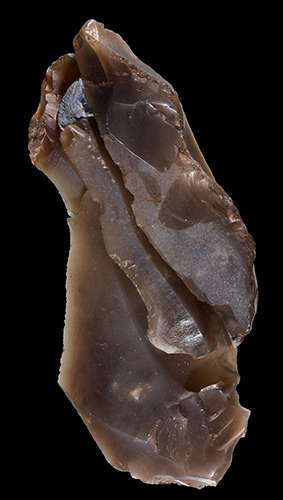
Joint - Refitting flakes and blades back onto the original core to determine the knapping sequence.
A blunted burin refitted onto its core.
Blunted burins were made by first blunting the end of a blade, then using one or more burin blows on the blunted platform to create the burin edge.
Length 84 mm.
Collection: © Maarten Perdeck
Photo: © Christophe Brochard
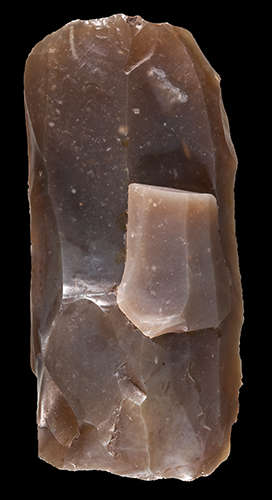
Joint - Refitting flakes and blades back onto the original core to determine the knapping sequence.
A broken blade refitted to the nucleus or core.
Length 70 mm.
Collection: © Maarten Perdeck
Photo: © Christophe Brochard


Joint - the left hand image of an RA steker met holschaaf fits on the Beksteker on the right. See the drawings below.
Lengths, left to right: 82 mm, 95 mm. Identification (left to right): Z.36, Z.37
Maarten tells a story about this Beksteker:
One winter day, the soil was frozen hard to a depth of 10 cm, but still I felt the need to go there. With an iron tool I managed to lift a large piece of frozen soil, and there lay the top of tool Z.37, I immediately recognised it, at that time I had all stones in my head, after evenings and evenings looking at every piece.
Than suddenly the farmer stood behind me.
'Looking for gold?' he asked.
'No, just stones' was my answer. 'Nothing special today' I said, showing him that beautiful beak. In those times no one wondered why I was always there. When they worked on the field with 4 tractors I could walk undisturbed between them, no one stopped or questioned anything.
Besides the movement of soil and artefacts attributable to ploughing over a period of many years, other factors would have been at work in distributing the tools through the top soil layer of the field. After the reindeer hunters were long gone, and the climate became warmer, a large forest grew on the site, until Neolithic farmers 5 000 years ago cut down the trees and planted crops.
In a forest there is a constant but slow movement of soil, sometimes quite deep, as well as the fall of the trees through old age or high winds. As well, there are badgers nearby, just 100 metres away, and they dig enormous holes.
Collection: © Maarten Perdeck
Photo: © Christophe Brochard
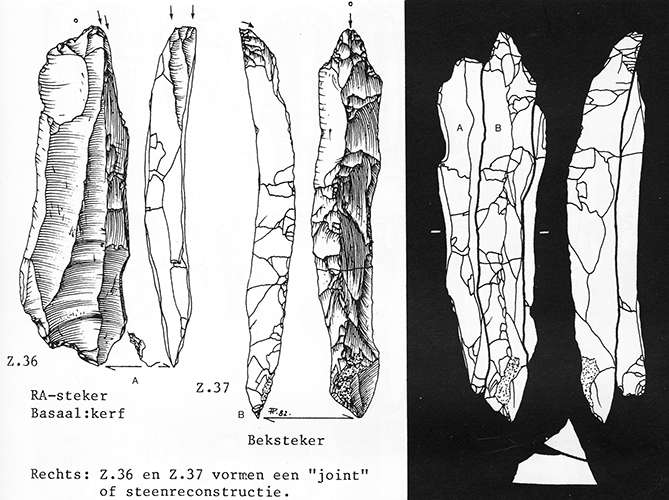
Joint - the left hand image of an RA steker met holschaaf fits on the Beksteker on the right.
Identification (left to right): Z.36, Z.37
Collection: © Maarten Perdeck
Photo: Perdeck (1993)
Drawing: Tekening: Hans Peeters
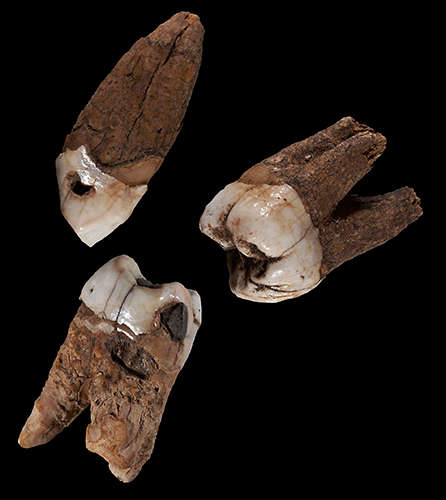
Kiezen en tanden - Human teeth.
Maarten writes:
The strangest things I found there were human teeth, modern with amalgam fillings. My dentist said that someone had been killed or buried there.
Why not take the corpse to the graveyard?
Perhaps it was during WWII. At that time it was not possible to bury publicly the body of a hidden Allied pilot, or a Jew, or a German who had been killed.
Collection: © Maarten Perdeck
Photo: © Christophe Brochard
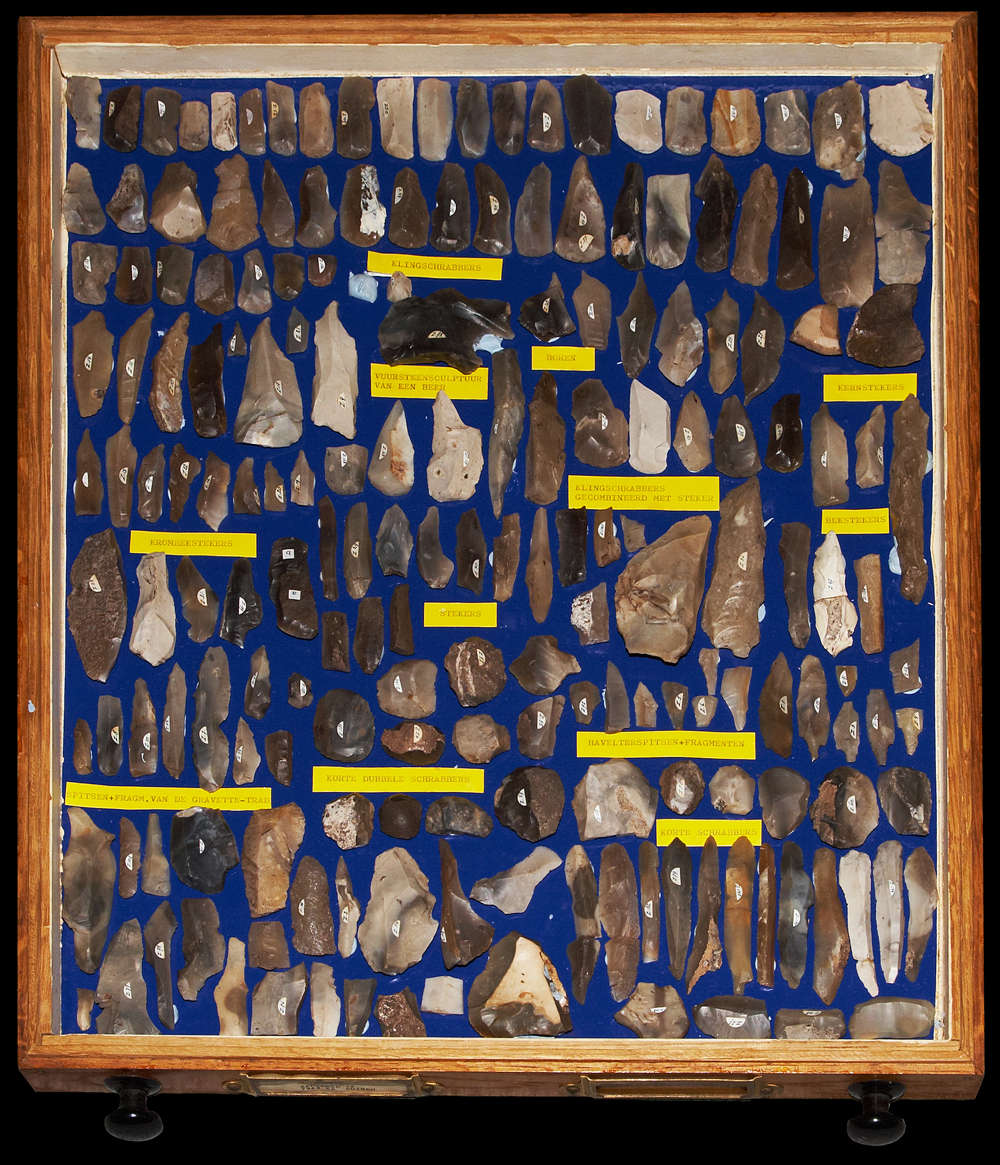
The work of a lifetime, the wonderful result of twenty years of work on the one site, the major finds presented here in the drawer in which they are kept.
Collection: © Maarten Perdeck
Photo: © Christophe Brochard
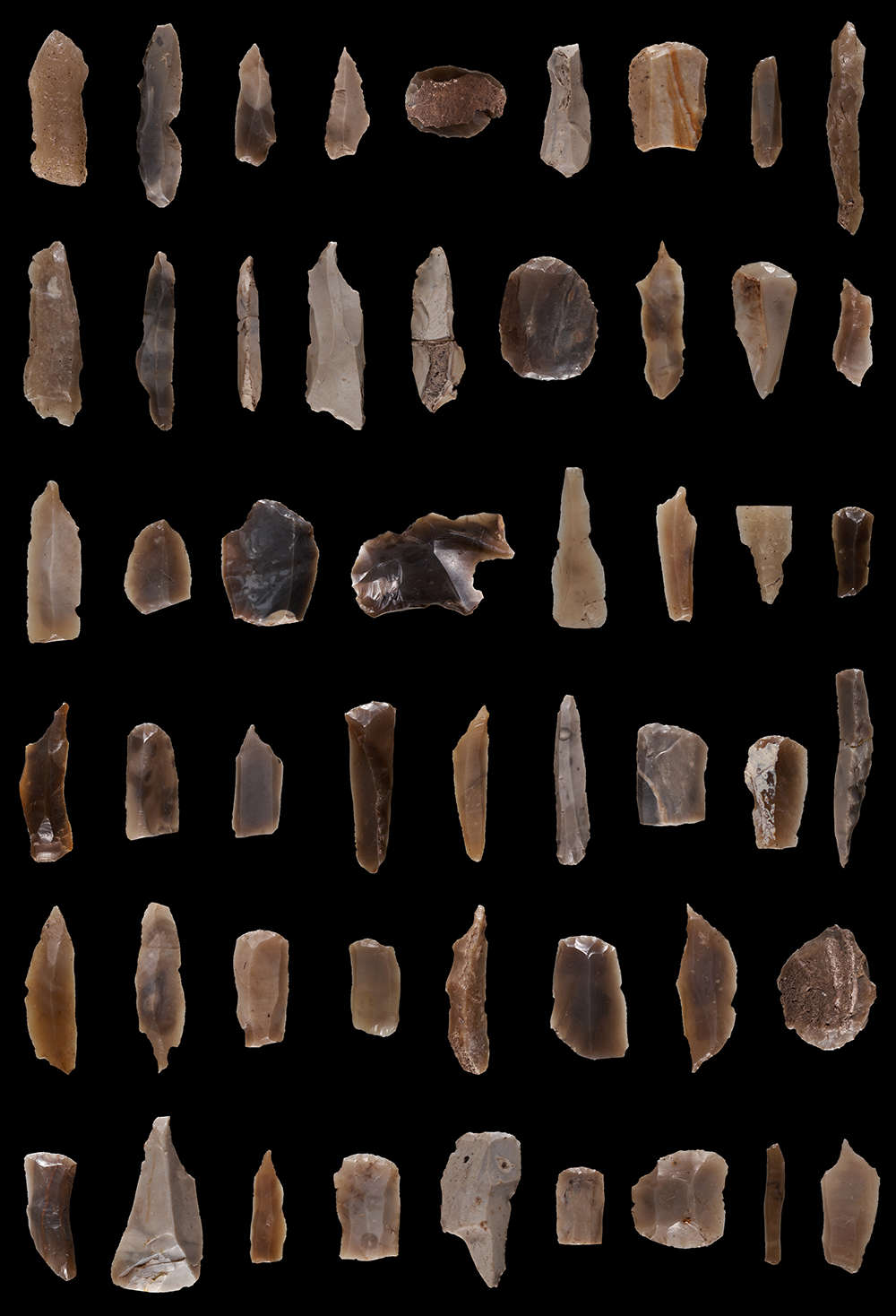
The major finds presented here on a black background. The finds shown in this image are not to scale.
Collection: © Maarten Perdeck
Photo: © Christophe Brochard
References
- Äikäs, T., Vaneeckhout, S., Junno J., Puputti A., 2010: Prehistoric burned bone: use or refuse – results of a bone combustion experiment, Faravid, 2010/34: 7–15.
- Baron, D., Kufel-Diakowska, B., 2011: Written in Bones - Studies on technological and social contexts of past faunal skeletal remains, Uniwersytet Wrocławski,I nstytut Archeologii Wrocław 2011
- Baron, J., Michel, A., 2008: Le burin des Vachons : apports d’une relecture technologique à la compréhension de l’aurignacien récent du nord de l’Aquitaine et des Charentes, Paléo,18, 2008, 143-160
- Bibby, G., 1956: The Testimony of the Spade, Alfred A. Knopf, 424 pp.
- Burdukeiwicz, J., 1999: Late Palaeolithic Amber in Northern Europe, Investigations into Amber, Proceedings of the International Interdisciplinary Symposium, 2 - 6 September 1997 Gdansk, The Archaeological Museum Gdansk, Museum of Earth, Polish Academy of Sciences, Gdansk, 1999, pp 99-110.
- Caselli, G., 1985: The Everyday Life of an Ice Age Hunter, Macdonald & Co.
- Cheynier, A., 1963: Les burins, Bulletin de la Société préhistorique de France, 1963, tome 60, N. 11-12. pp. 791-803.
- Clark, G., 1966: Prehistoric Europe, Stanford University Press
- Delarue, R., Vignard E., 1959: Le grattoir-bec : un nouvel outil du Paléolithique supérieur, Bulletin de la Société préhistorique de France, 1959, tome 56, N. 5-6. pp. 358-363.
- Grimm, S., Jensen, D., and Weber, M., 2012: A lot of good points - Havelte points in the context of Late Glacial tanged points in Northwestern Europe, in A mind set on flint, Studies in honour of Dick Stapert. Groningen Archaeological Studies 16 (Groningen 2012), 251-266, Niekus, M. J. L. T., Barton, R. N. E, Street, M. & Terberger, T. (eds.)
- Grimm, S., and Weber, M., 2008: The chronological framework of the Hamburgian in the light of old and new 14C dates, Quartär, 55 (2008) : 17 - 40
- Howell, F., 1965: Early man, Life Nature Library. Time, Inc. New York 1965
- Inizan, M., Reduron-Ballinger, M., Roche H., Tixier J., 1999: Technology and Terminology of Knapped Stone, Préhistoire de la Pierre Taillée, CREP, Cercle de Recherches et d'Etudes Préhistoriques Maison de l'Archéologie et de l'Ethnologie (Boîte 3) 21, allée de l'Université - 92023 Nanterre Cedex - France Tome 5
- Instituut voor het Archeologisch Patrimonium (Zellik), 1994: Rekem, a Federmesser Camp on the Meuse River Bank, Volume II, Archeologie in Vlaanderen: Monografie, Leuven University Press, 1994, ISSN 1370-5768
- Movius H.L. Jr, David N., Bricker H., Clay B., 1968: The analysis of certain major classes of upper palaeolithic tools: Stratigraphy, American School of Prehistoric Research, Peabody Museum, Harvard University, Cambridge, Massachusetts
- Niekus, M., Street M., Barkhuis, T., 2012: A Mind Set on Flint: Studies in Honour of Dick Stapert, Groningen Archaeological Studies, 539 pp., ISBN -13: 9789491431135, ISSN: 1572-1760
- Pedersen, K., 2013: Humans and reindeer at Slotseng - 12 years after, Union Internationale des Sciences Préhistoriques et Protohistoriques,The Final Palaeolithic of Northern Eurasia, Schloss Gottorf, Event Date: Nov 6, 2013, https://www.academia.edu/5092764/Humans_and_reindeer_at_Slotseng_-_12_years_after
- Perdeck, M., 1993: Na 10 Jaar, APAN/EXTERN, 2 (1993).
- Pesesse, D., Michel A., 2008: Le burin des Vachons : apports d’une relecture technologique à la compréhension de l’aurignacien récent du nord de l’Aquitaine et des Charentes, Paléo, 18, 2008, 143-160
- Piette, E., 1907: L'art pendant l'Age du renne, Edouard Piette. - Paris: Masson & Cie., 1907. Pl. 60
- Riede, F., 2010: Hamburgian weapon delivery technology: a quantitative comparative approach, Before Farming, 2010, 1, ISSN 1476-4253
- Straus, L., 1996: Humans at the End of the Ice Age: The Archaeology of the Pleistocene-Holocene Transition, Springer, 30 Jun 1996 - History - pp. 378
- Weber, M., Grimm, S., 2007: Dating the Hamburgian in the Context of Lateglacial Chronology, Chapter One, Chronology and Evolution within the Mesolithic of North-West Europe: Proceedings of an International Meeting, Brussels, May 30th-June 1st 2007 , ed. Crombé P., Van Strydonck M., Sergant J., Boudin M., Bats M.
- Winick, C., 1956: Dictionary of Anthropology, Philosophical Library, 18 Dec 1956 - Social Science - 591 pages
Back to Don's Maps
 Back to Archaeological Sites
Back to Archaeological Sites
